The Rubbee is an affordable electric drive system designed to clamp onto the back of nearly any regular “human powered” bicycle and convert it into an efficient “pedal assisted” ebike that will climb easier and go further. I love the aesthetics on this thing, a lot of attention was paid to the paint job, routed logo, integrated LED backlight, twist-click power connector, beeping alert system and easy-install pedalec sensor. Unfortunately, compared to most of the purpose built and converted electric bikes I’ve reviewed (that rely on hub motors or mid-drive systems) it feels under powered. I’ve tested other ebikes that were limited to ~15 mph (designed to satisfy a European and global market) but this one felt slower and less zippy. There’s also no display panel showing your distance, charge level or speed so the Rubbee feels a bit detached. One thing is for certain, running out of batteries far from home would be a big bummer. The entire kit (drive system, wires and pedal sensor) weigh just under 16 pounds (7.3 kg) which isn’t too bad but the rubber friction drive slows you down if it isn’t powered on as demonstrated in the video. While it is possible to “disengage” the Rubbee and coast more efficiently, you may risk breaking the locking pin that holds it up. This actually happened during our tests while walking the bike off of a curb and from then on the unit was permanently engaged. I’m told that the pin is actually designed to break off clean (as it did for me) so that it can be replaced vs. being bent and jamming in the “up” position. This is a difficult review to do because the Rubbee team has been very responsive and professional, their two year warranty is excellent and the product seems neat… it just didn’t perform that well during my tests.
The motor in the Rubbee is a 250 watt gearless canister design that’s mounted inside the rubber friction wheel at the end of the unit. It peaks at 560 watts according to the company and benefits from a huge mechanical advantage, being positioned at the perimeter of the wheel instead of the center like traditional hub motors. Motor speed is translated to torque and power and it works alright but there is some noticeable whirring (even if the unit is off). Depending on what tires you use, there’s a noticeable buzzing as tire studs pass the rubber traction point. Depending on your weight and the terrain, the Rubbee will shut itself off to avoid overheating which is a neat feature in terms of self preservation. The downside is that you may be left to climb on your own… with the extra weight… and the drag of the motor system which will likely still be engaged with the rear wheel. You could always swivel the unit up and disengage but in tern risk braking the pin off as we did. I feel like this is one big area where the unit could definitely be improved. If I didn’t have to worry about the pin breaking I might be able to leave the unit up more often and that would reduce range anxiety. One possible downside is that in the up position, dropping a curb could still stress my seat post. On this topic… I would not recommend using this kit with any type of carbon fiber seat post as you could crack the post.
Powering the Rubbee Drive 2.0 is a Lithium Iron Phosphate battery pack offering 14.4 volts of power and 20 amp hours of capacity. The overall watt hours are decent at ~288 but you’re getting less power with this battery design than a traditional 36 volt 10 amp hour pack found on most other ebikes I review (in Europe the standard is more like 24 volts with 10 amp hours). Lower voltage may not be an issue here because of the motor design. Rubbee estimates that their system will get upwards of 20 miles per charge and this seems right to me given the assist-only design. There’s no throttle mode here, you have to pedal to keep it going. Since they used a cadence sensor here however, I found that you don’t have to push especially hard (after the bike is moving) to get the motor to activate and continue on. Still, even when it is going, it just doesn’t feel that satisfying. LiFePO4 batteries are known for being durable and long lasting, they make up the majority of the weight on the Rubbee at ~6.5 lbs and since the unit is super easy to clamp on or take off you can easily store them inside (in a cool dry place ideally) to extend their life and charge them up after each ride. I’m not sure how easy the cells would be to replace or if there’s a program for doing that but after 1,500+ charge cycles the unit may be pretty well worn. I noticed that rubber dust began accumulating around the back and under side of the unit after less than 10 miles and I’m not sure if that was from the friction roller or the tires?
Mounting and operating the Rubbee is easy and intuitive. The coolest parts are the slim, light weight 1.3 lb charger unit (that could easily be carried along to work or a friend’s house), the integrated LED light at the back and the unique twist-click power plugs. You can charge the battery completely in ~3.5 hours and once it’s ready you pick the entire thing up by the leather handle and carefully mount it to your seat post. You will need 80 mm of vertical space on the tube (so petite people who have their seat very low to reach the pedals may find that the system disrupts their ergonomics). The clamp is all metal, there’s no rubber liner or shims to protect from scratching the tubing but I do not have evidence that this would happen, I’m merely comparing it to beam racks I’ve had in the past which do. Maybe given the weight and forces exerted by the unit having metal on metal is more ideal? The clam will fit any seat post with diameters from 22 mm to 35 mm which is great. Once it’s on, you press a little power button that lights up blue and then you’re ready to go! As your pedal cranks move, a plastic disc with 12 magnets passes an electronic sensor and signals for the Rubbee to kick in. There are no modes or levels of power to choose from, this thing is basically working or it’s turned off. But we’ve skipped a big important piece here and that’s installation…
Installing the Rubbee 2.0 pedelec sensor system was fairly easy and did not require special tools thanks to the included half-disc setup. Basically, there’s a circular plastic disc that can be pulled apart along the center and then clicked back together around the crank axle of your bike. there’s a nice metal c-ring that keeps the two pieces together once it’s mounted and then all you have to do is align the electronic sensor to the magnetic dots by sticking it to the seat tube or chain stay tube. I think the picture below demonstrates it pretty well. Once the magnetic disc is on and the sensor probe has been secured you can zip tie wires along the downtube to clean up the aesthetic. At the other end of the sensor probe cable you’ve got that nice twist-connector which goes into the Rubbee. The company had actually sent me two different sensors to experiment with and the snap-on one was way easier and even more responsive than the more permanent version because it only had 10 magnets. This second system was also a huge pain to install as we had to take the cranks off and use special tools to remove the bottom bracket before installing correctly. In the video you may notice an extra plug hanging out in some of the shots and that was from this second sensor which we installed on the right side of the bottom bracket.
So after installing the Rubbee on a Giant Revel hardtail mountain bike (with 26″ wheels) and then swapping out the standard knobby tires for some smoother Schwalbe Fat Franks (to see how it would reduce noise and improve performance) I just wasn’t that impressed. The thing looks awesome and I love the idea of a completely removable, self contained drive unit but the results were lacking. I’ve actually tried other older electric powered friction drive units that rely on the same concept as the Rubbee and had a much better time. Even if it wasn’t able to hit 20 mph which is the standard in the US if they could make it zippier, make that rear wheel freewheel instead of causing drag and fix the vulnerable pin system that broke for us I would like it much more. I’m told that the unit rides more smoothly and drag is reduced after a while because the bearings in the motor loosen up. This is definitely a niche product and there are solid purpose built ebikes out there for ~$1,500 or you can experiment with other devices to convert your existing bike. I like the idea of using this with a folding bike, a full suspension mountain bike or anything in between but just because it could be used this way doesn’t mean I’d choose to do so after having experienced what it’s capable of. If you’re interested in this unit and live in America, check out Greenpath Electric Bikes in New York City which is one of their distributors.
Pros:
- The leather carry strap on top of the unit is handsome and feels sturdy, makes transporting the kit much easier
- It works on all sorts of bicycles including wheel sizes from 16″ up to 29″ and can even be used on full suspension setups because it has a spring built in to maintain contact with the rear wheel
- The unit looks beautiful, the paint job was done with powder coating for durability and the LEDs all match well, even the packaging it comes in is sleek and well designed
- Installing the Rubbee is surprisingly easy and fast, it could be added or removed from a bike without a lot of screwing around
- The battery charger is light weight and fairly small, it has a nice connection system that twists and clicks which feels strong
- The company is very professional and responsive to inquiries (at least the ones I sent) and they offer a solid two year warranty
- The new version is said to be even more powerful and responsive than the unit I tried so it should be more enjoyable to ride
- I’m told that with use, the drag from the motor bearings reduces and that the pin is actually designed to break off to avoid having it get bent and jamming instead, Rubbee offers replacement pins for ~$19
Cons:
- Cannot be used as a storage rack, do not load items or bags on top of the unit or try to hang them off of the side
- The lever and internal pin that secures the unit in the “up” or “disengaged” position broke when we walked the bike off of a curb and now the unit is permanently down in the “drive” position
- No heads up display showing how fast or far you’ve traveled, there is a battery level indicator but it’s on the unit and not very convenient to read
- While coasting, the Rubbee creates drag so if you run out of batteries it will feel heavy and make riding more difficult, you could disengage the unit but if you go off a curb it could break like our test unit did
- The Rubbee just didn’t feel very satisfying, it doesn’t offer a whole lot of power and isn’t capable of going very fast by American standards
- On bicycles with studded tires the Rubbee made extra noise because it connects directly to the tire
- There’s no throttle on demand option, in order to activate the unit you need to pedal and it isn’t super responsive at times
- Because there are no brake lever inhibitors and it uses a cadence sensor, the unit sometimes powers-on a bit longer than you might like
Resources:
- Official Site: http://www.rubbee.co.uk/
- More Pictures: https://goo.gl/photos/9nRmKA968LF8JP628


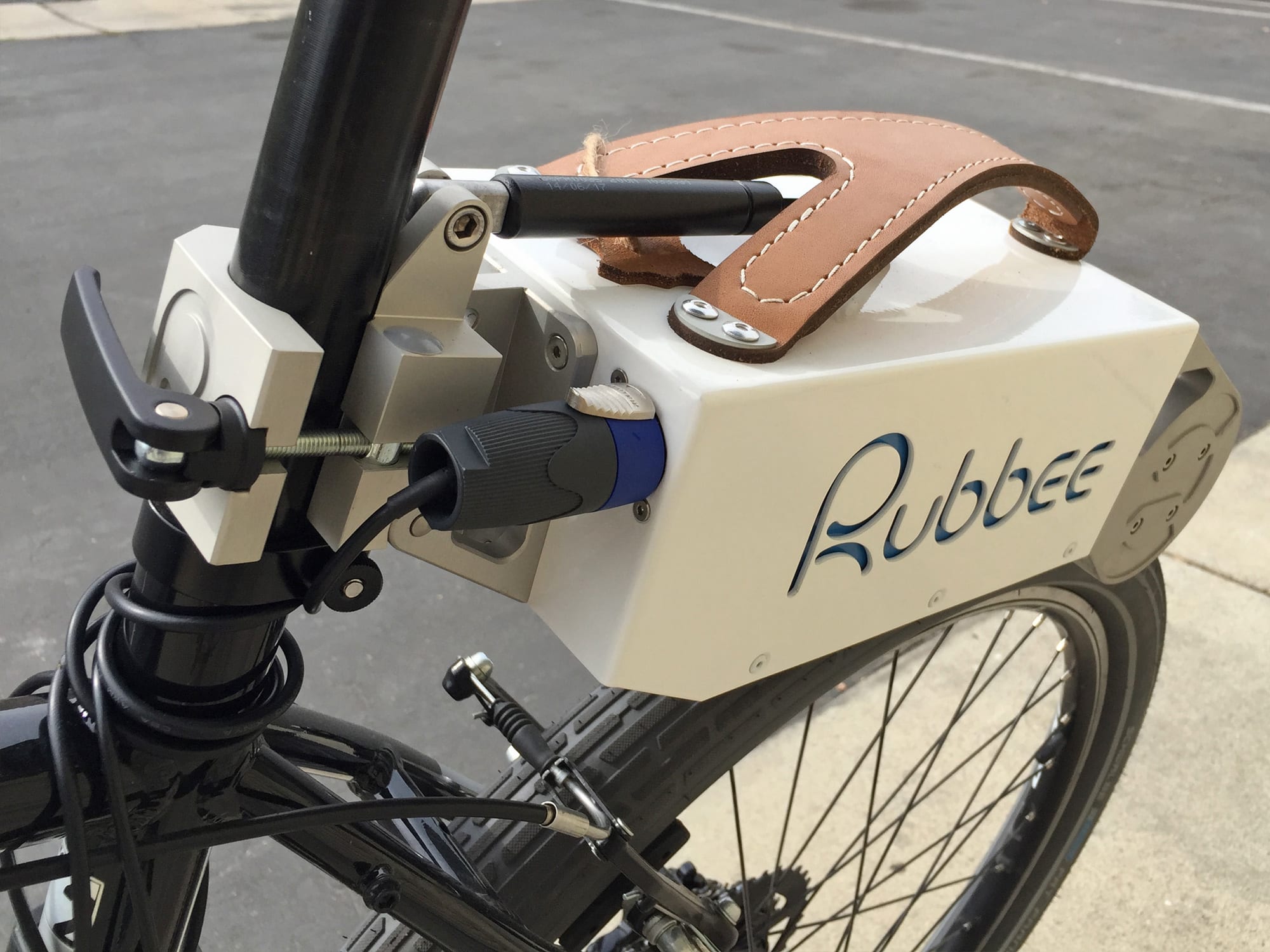
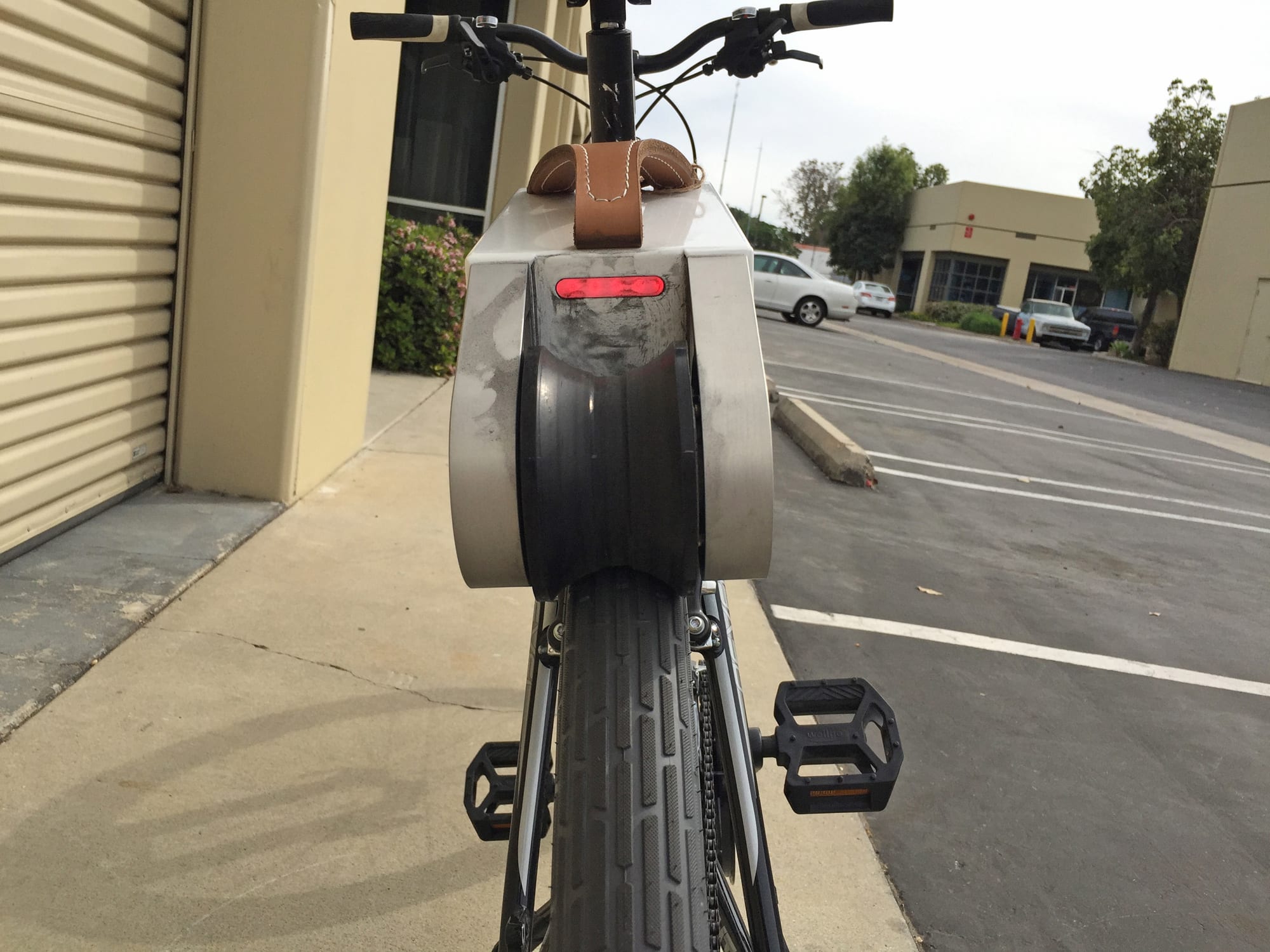

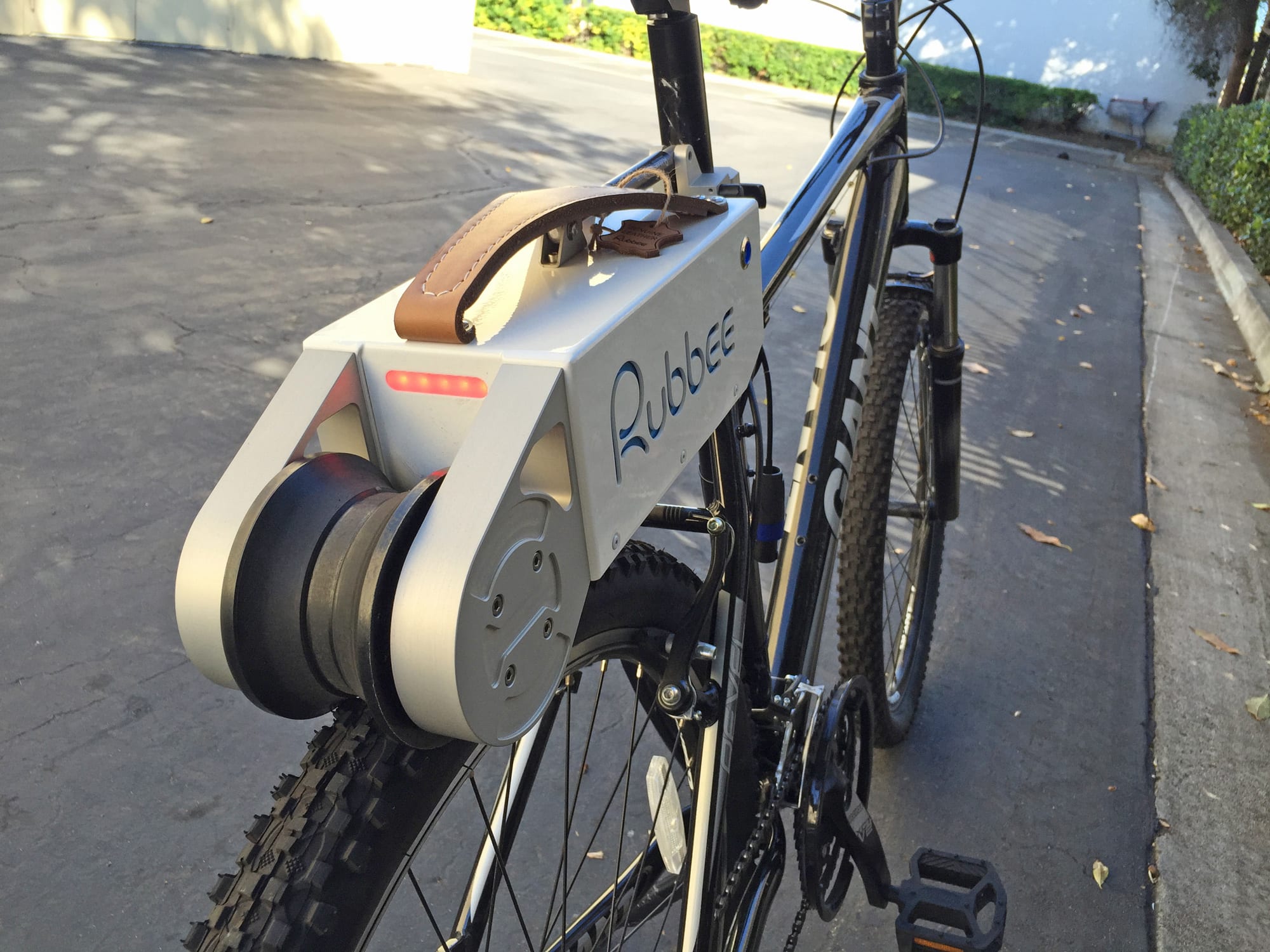

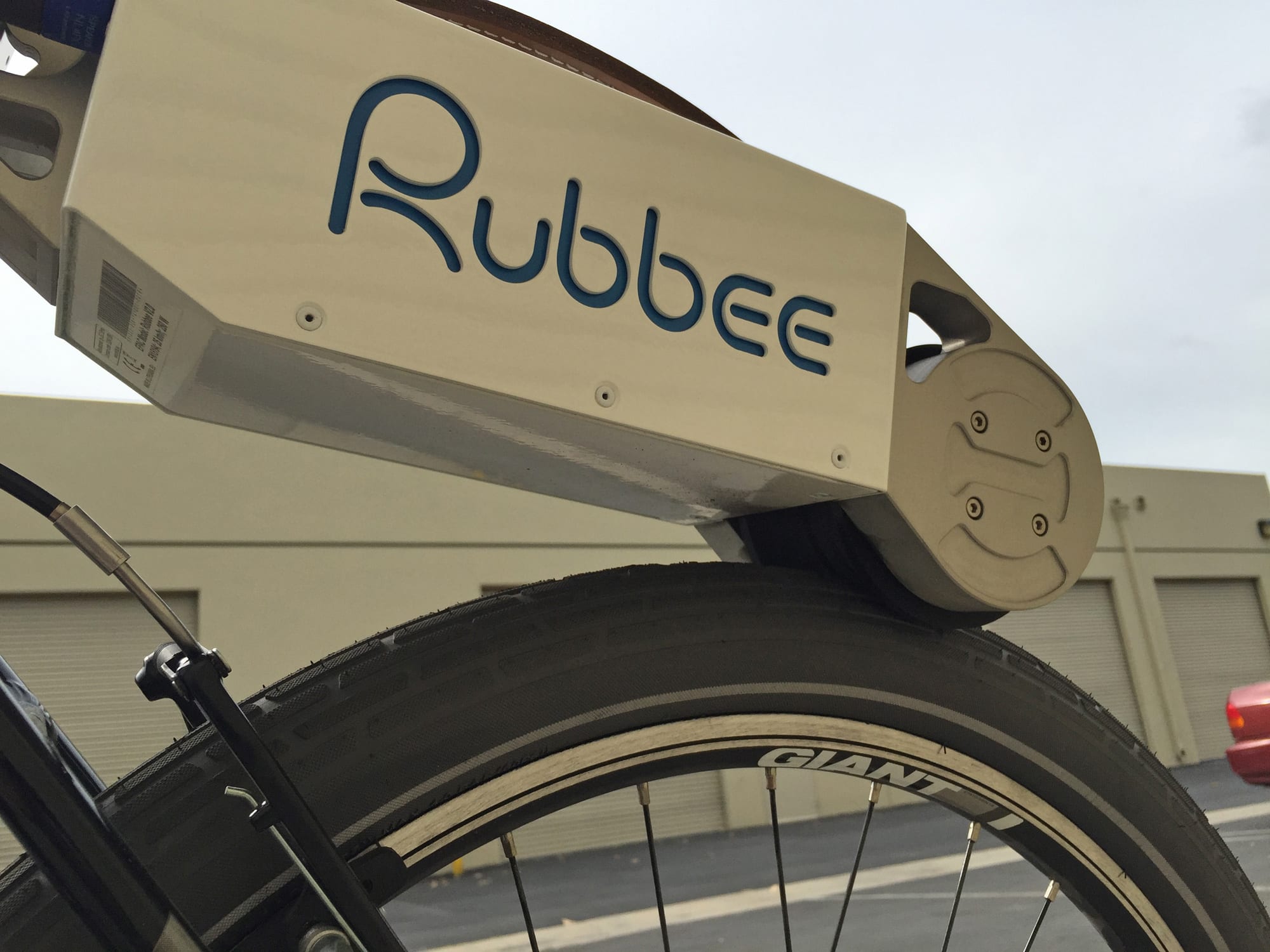
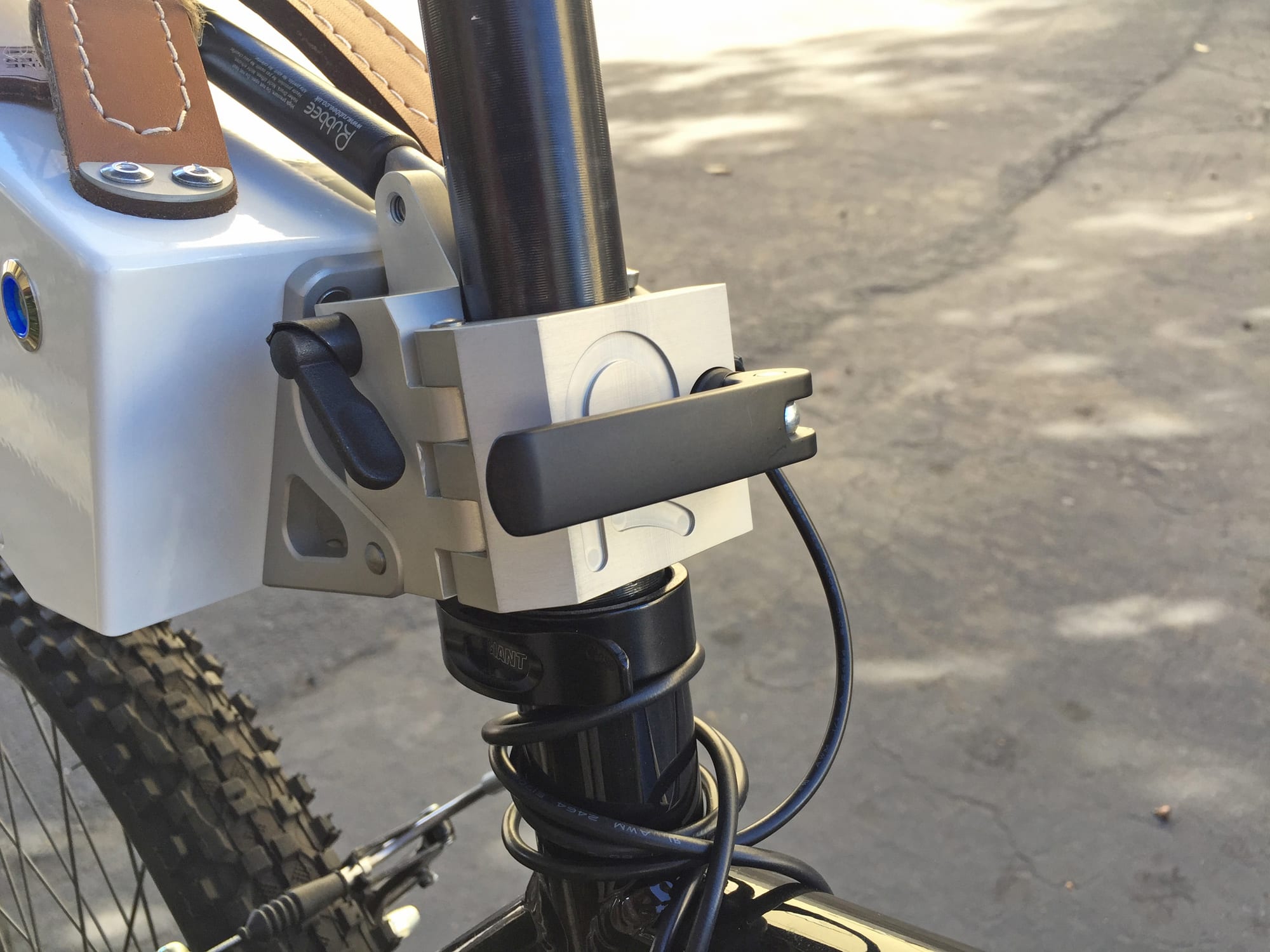
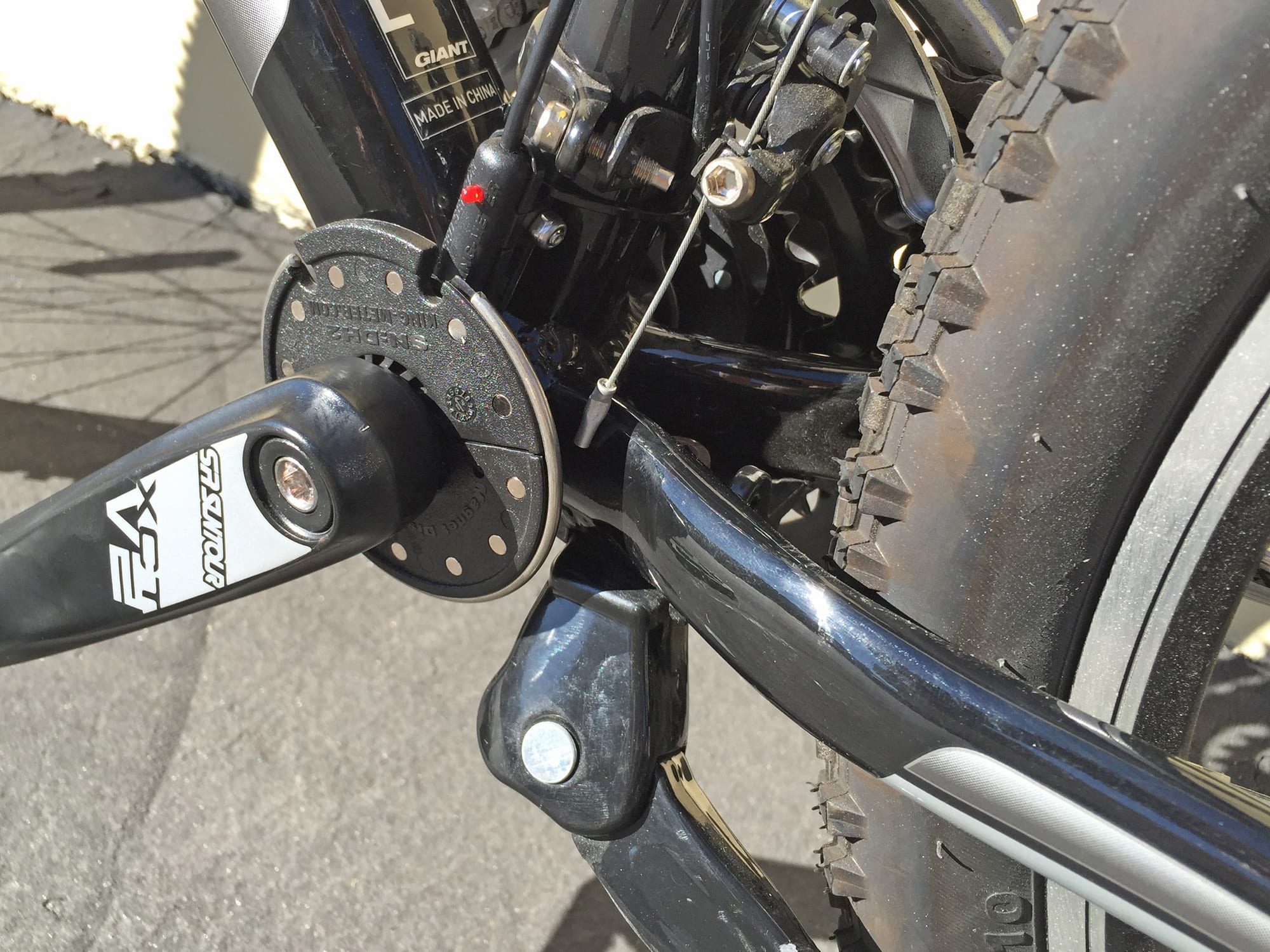
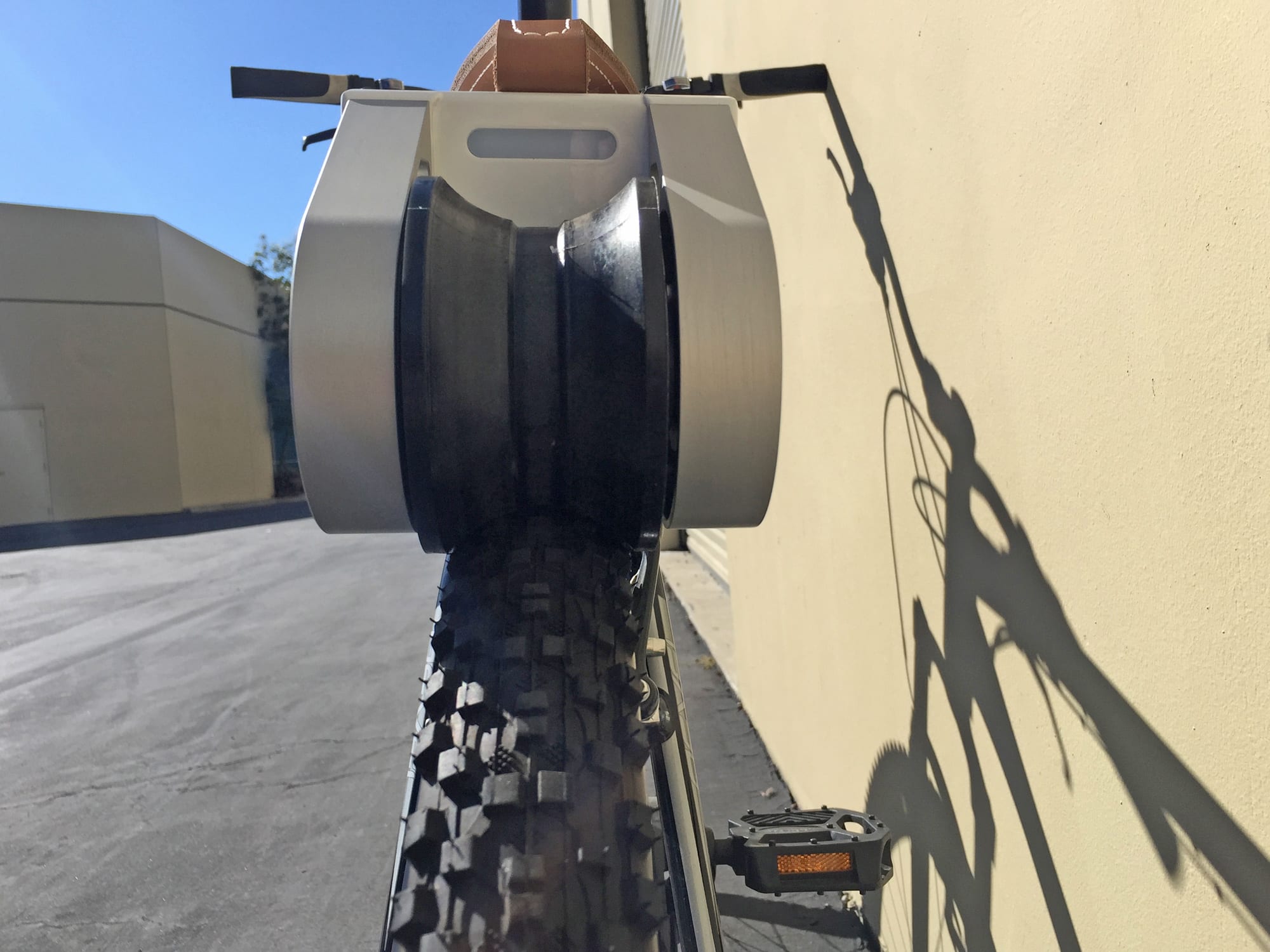
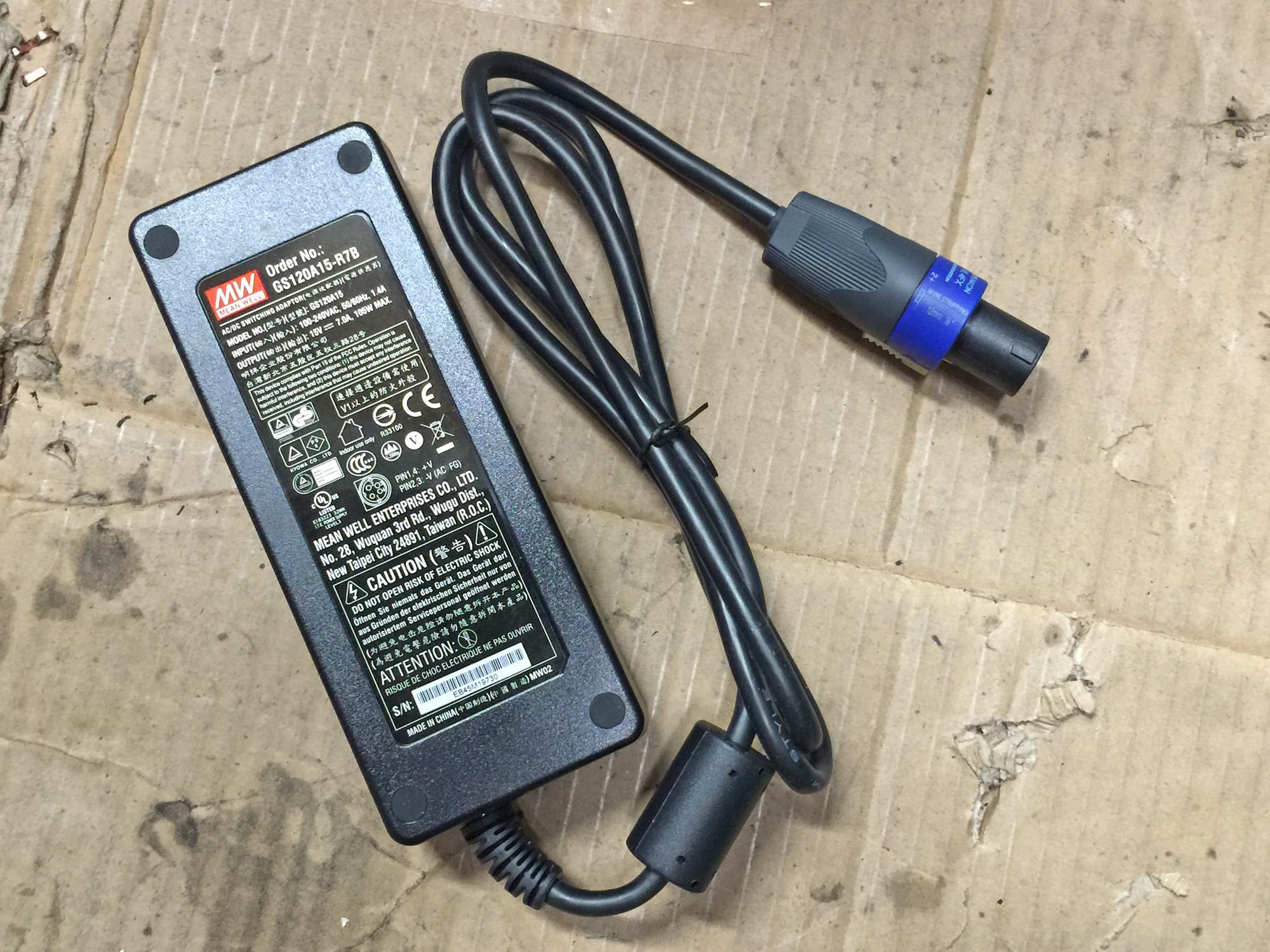
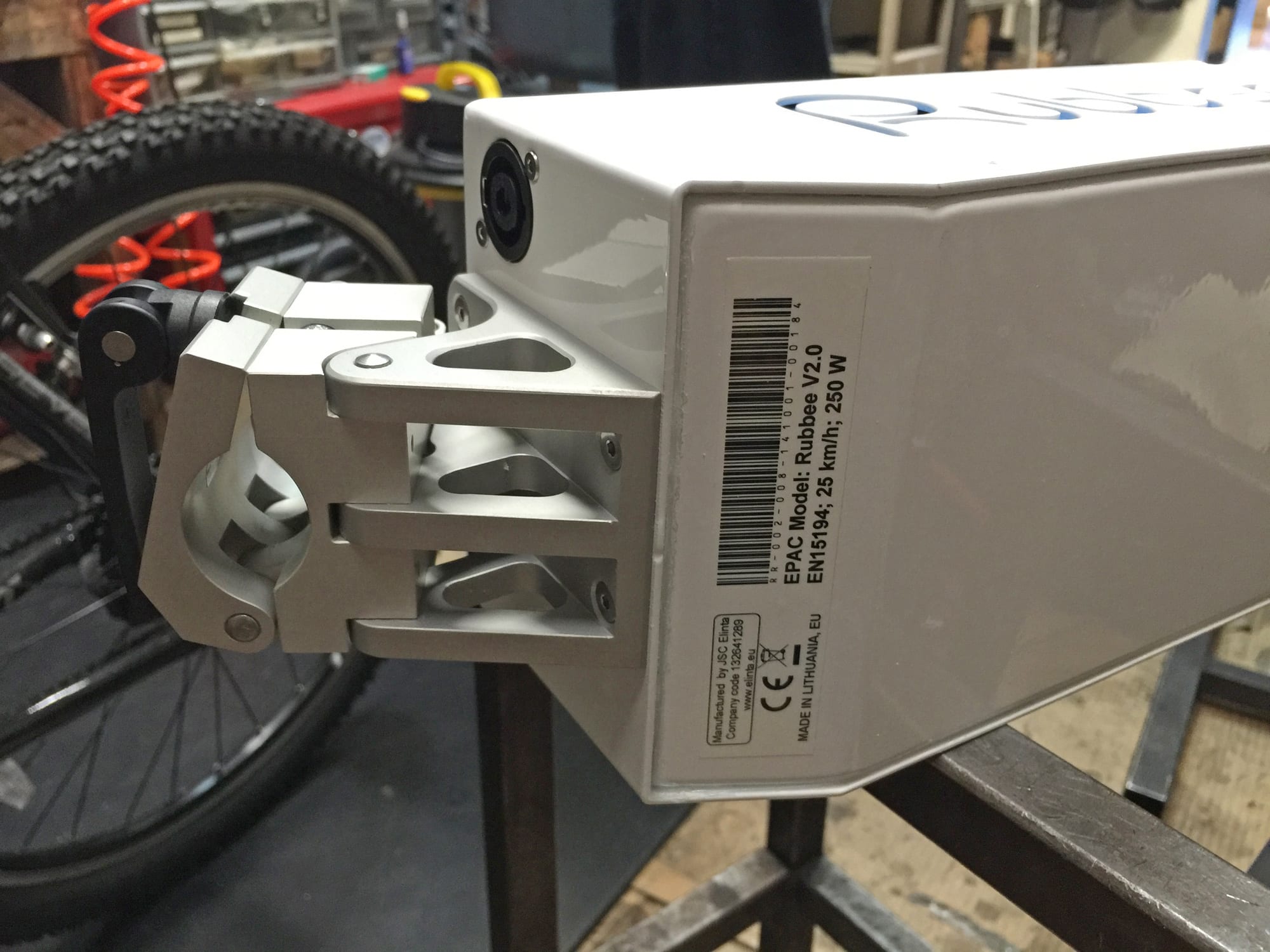
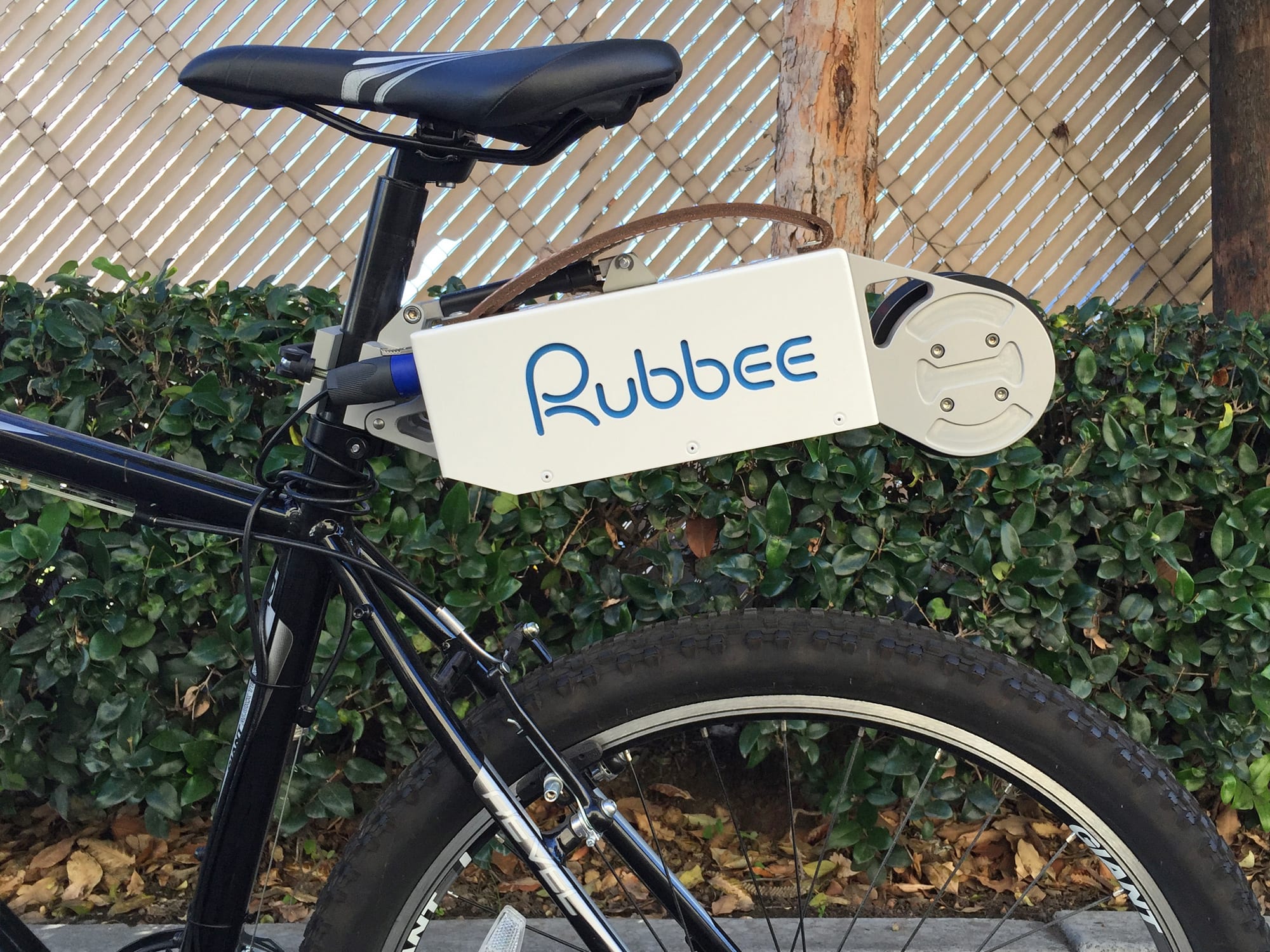
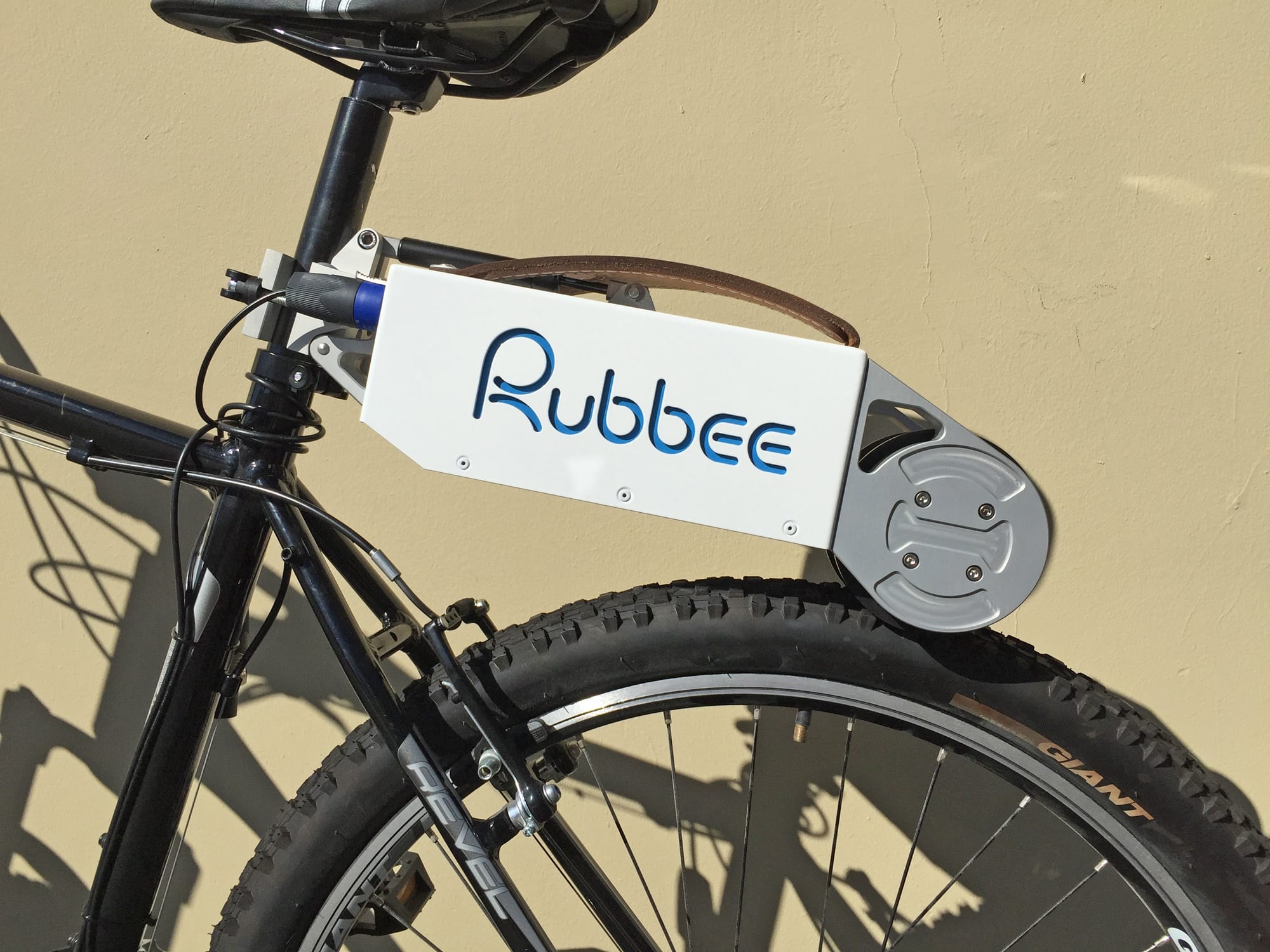
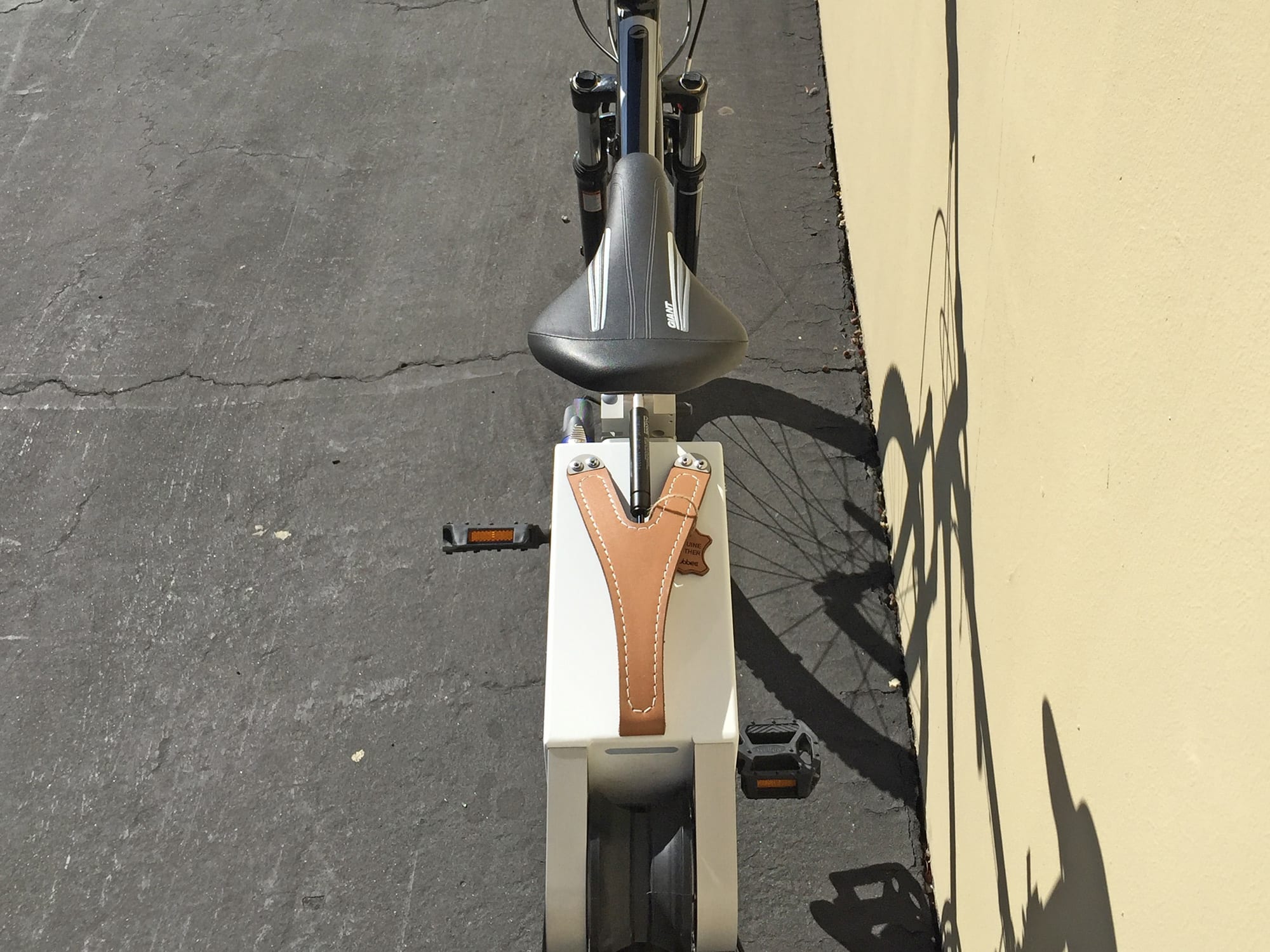

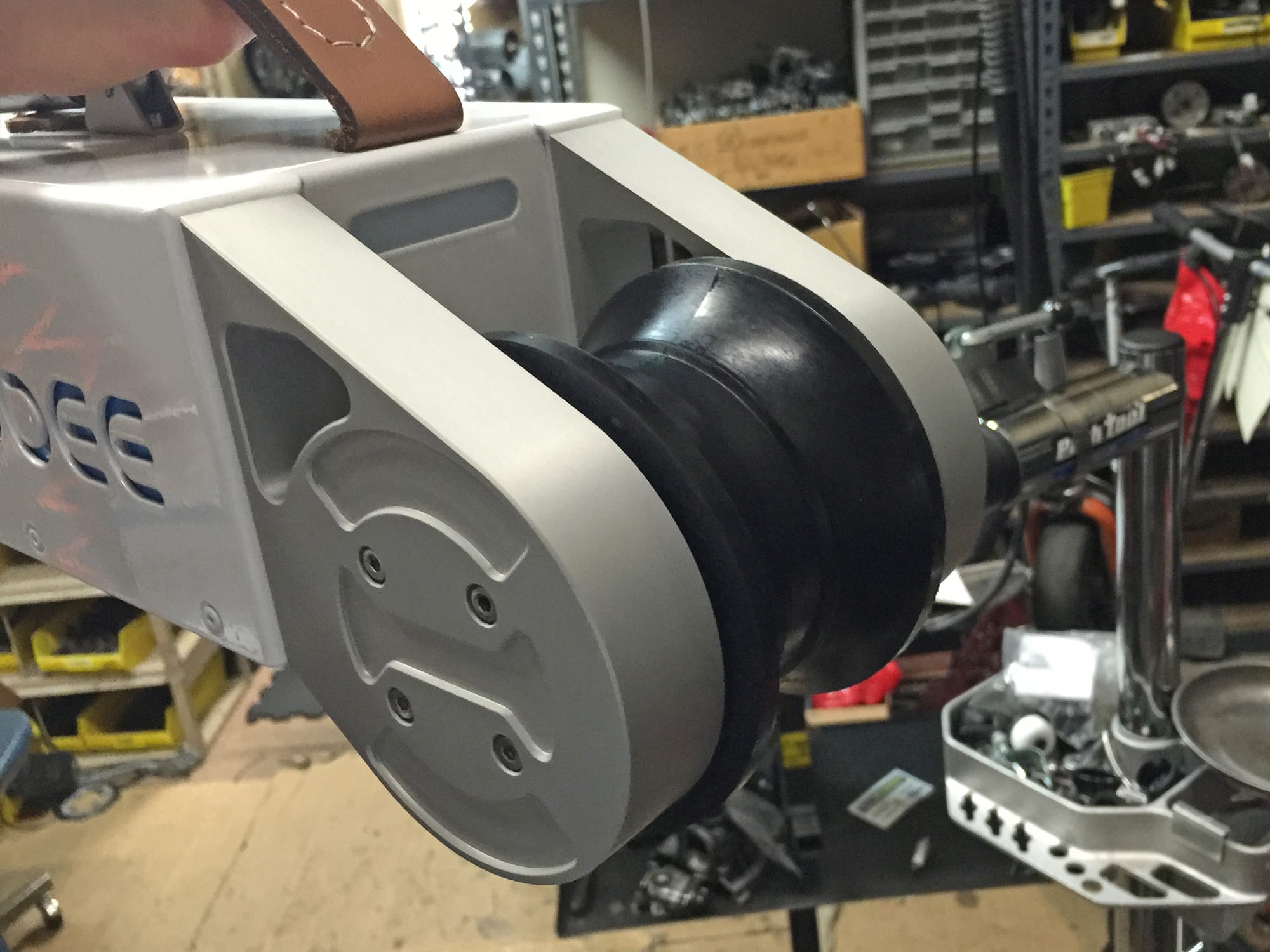
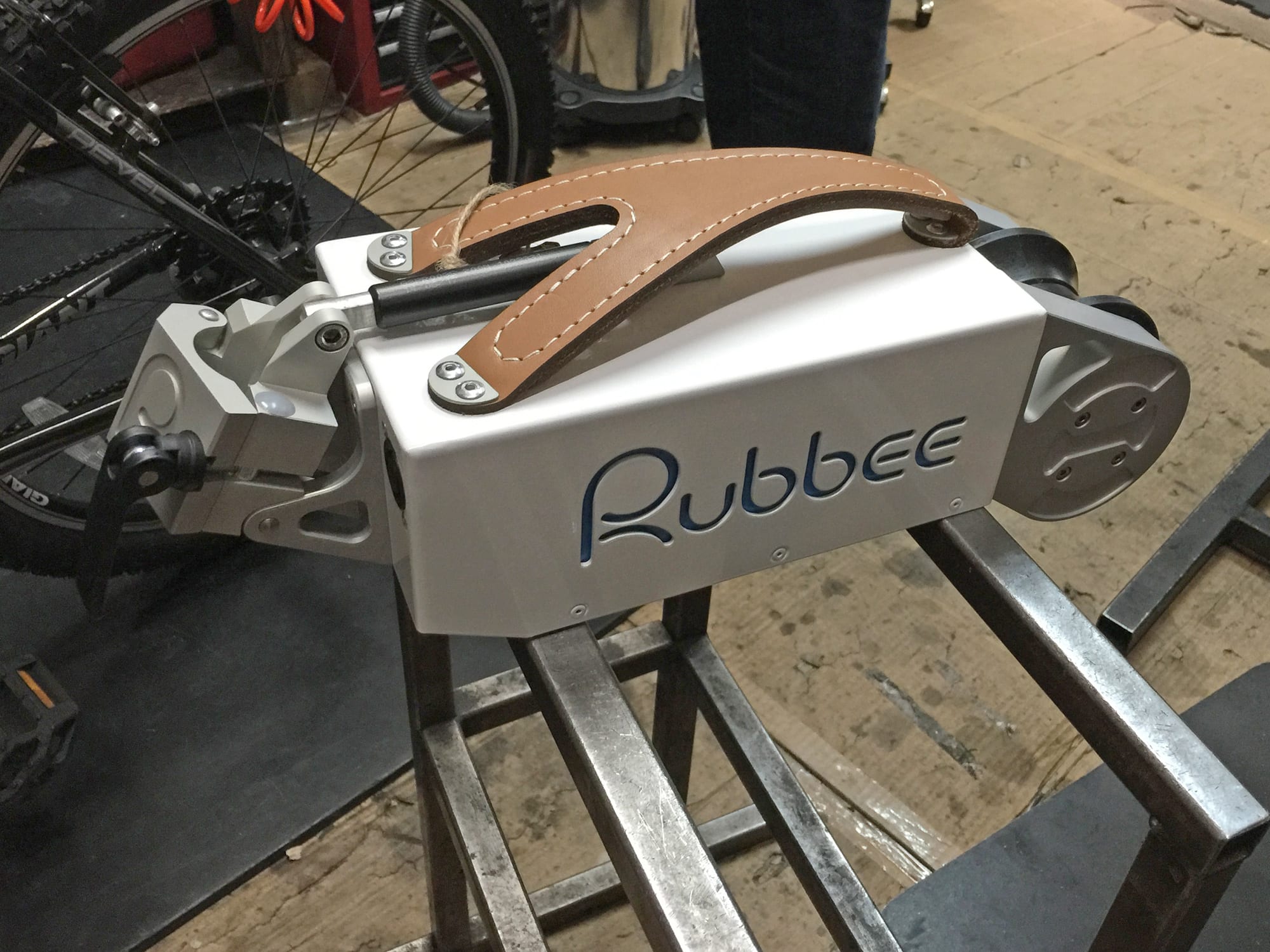
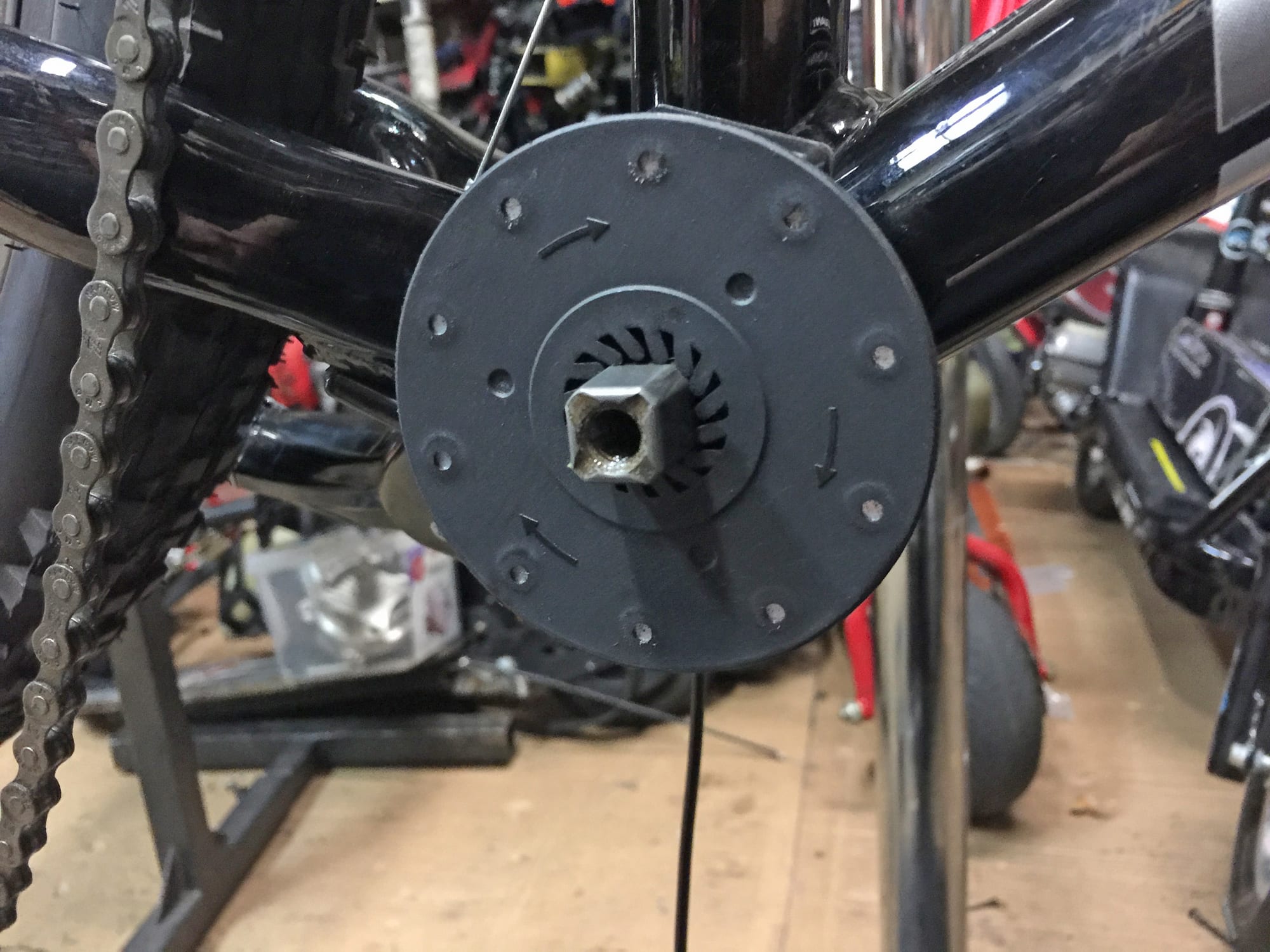
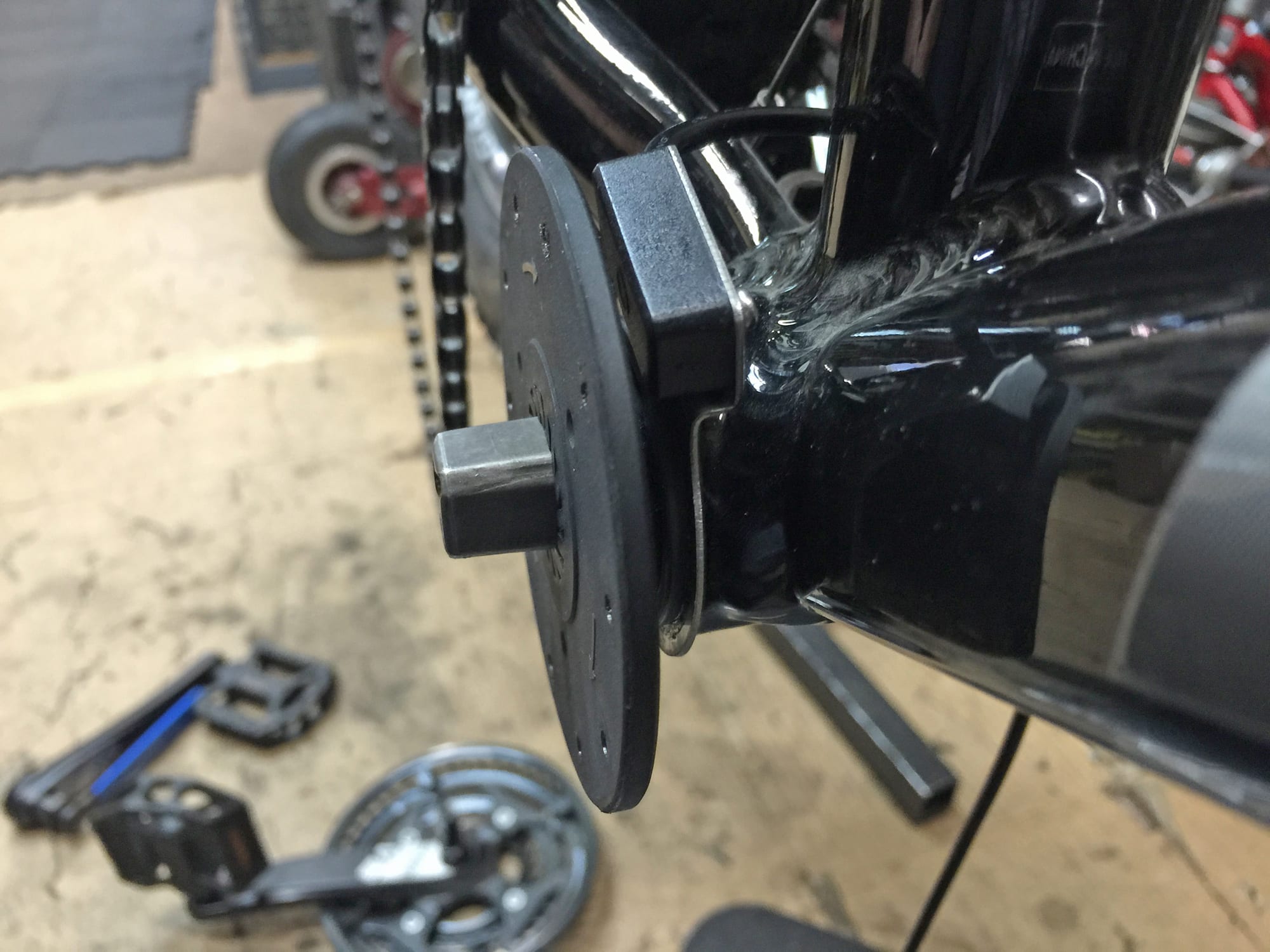
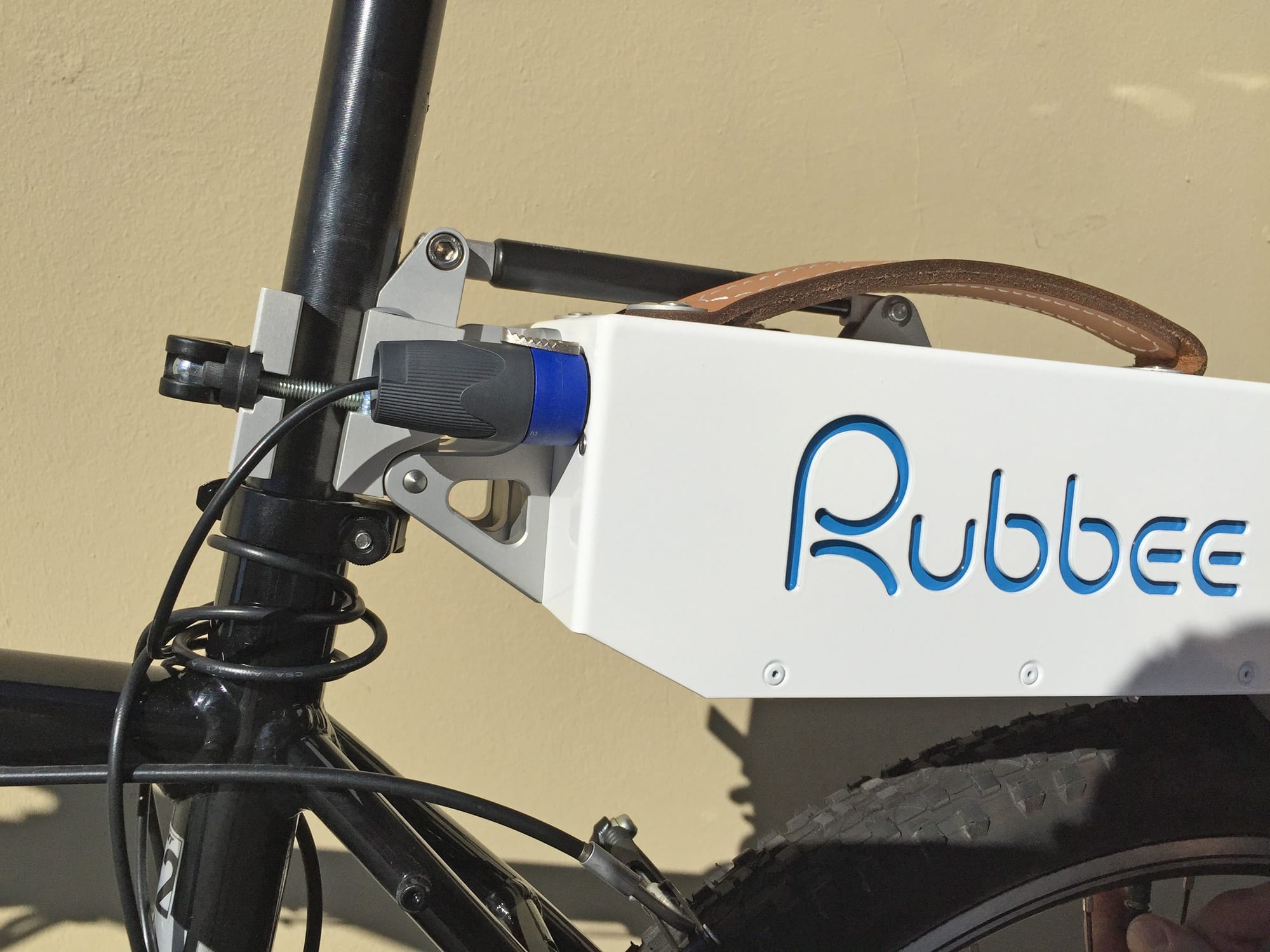
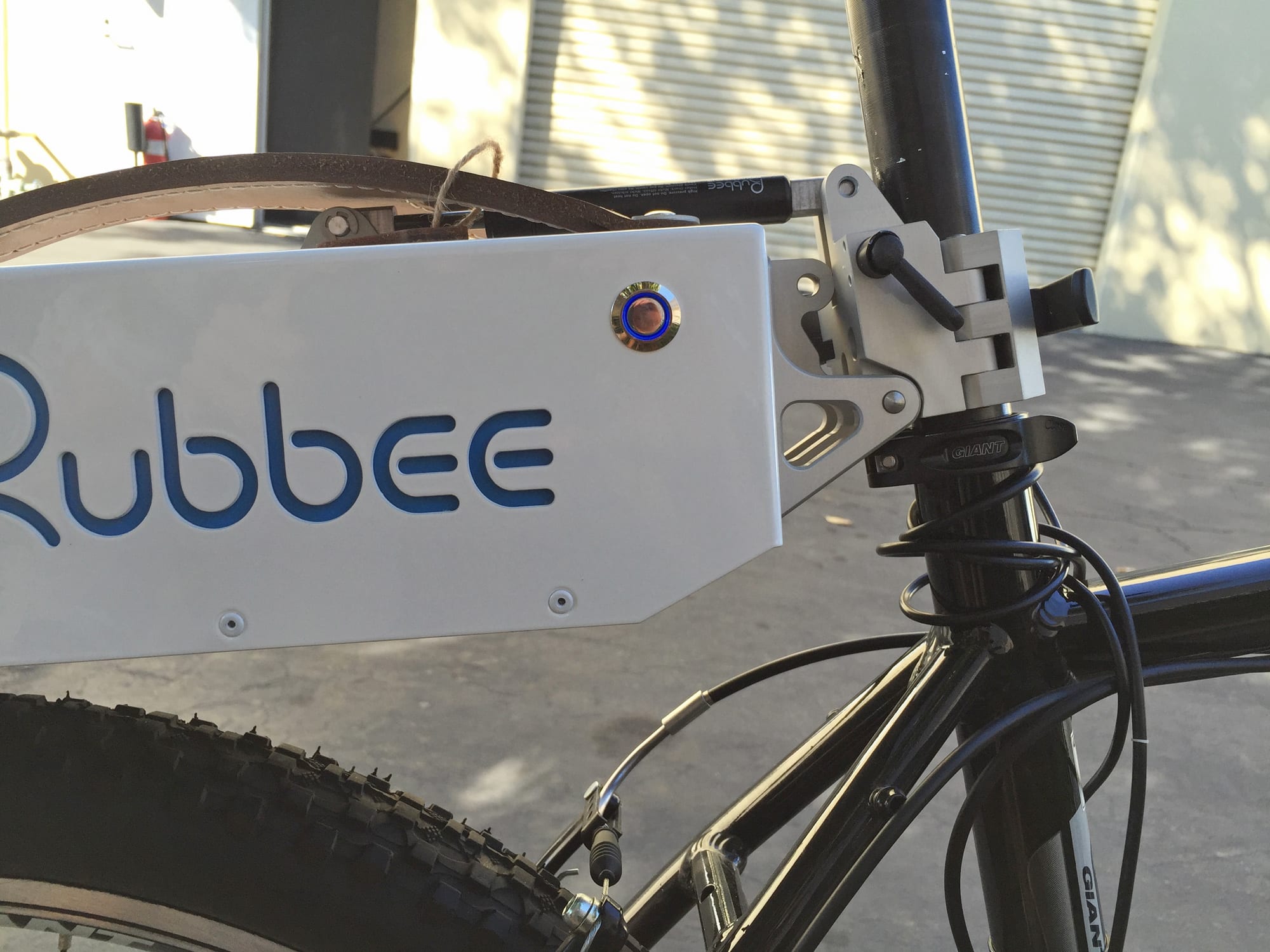
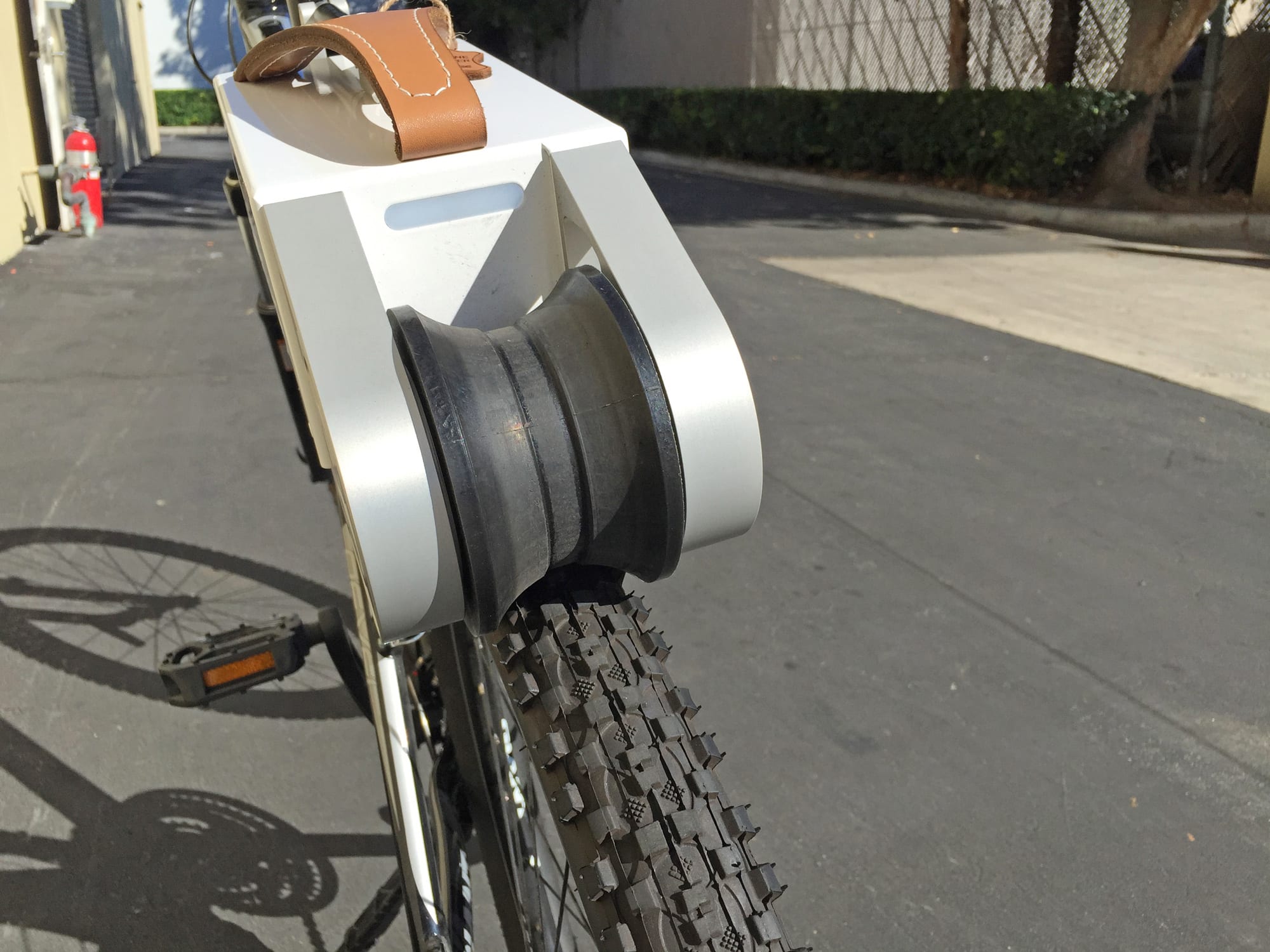
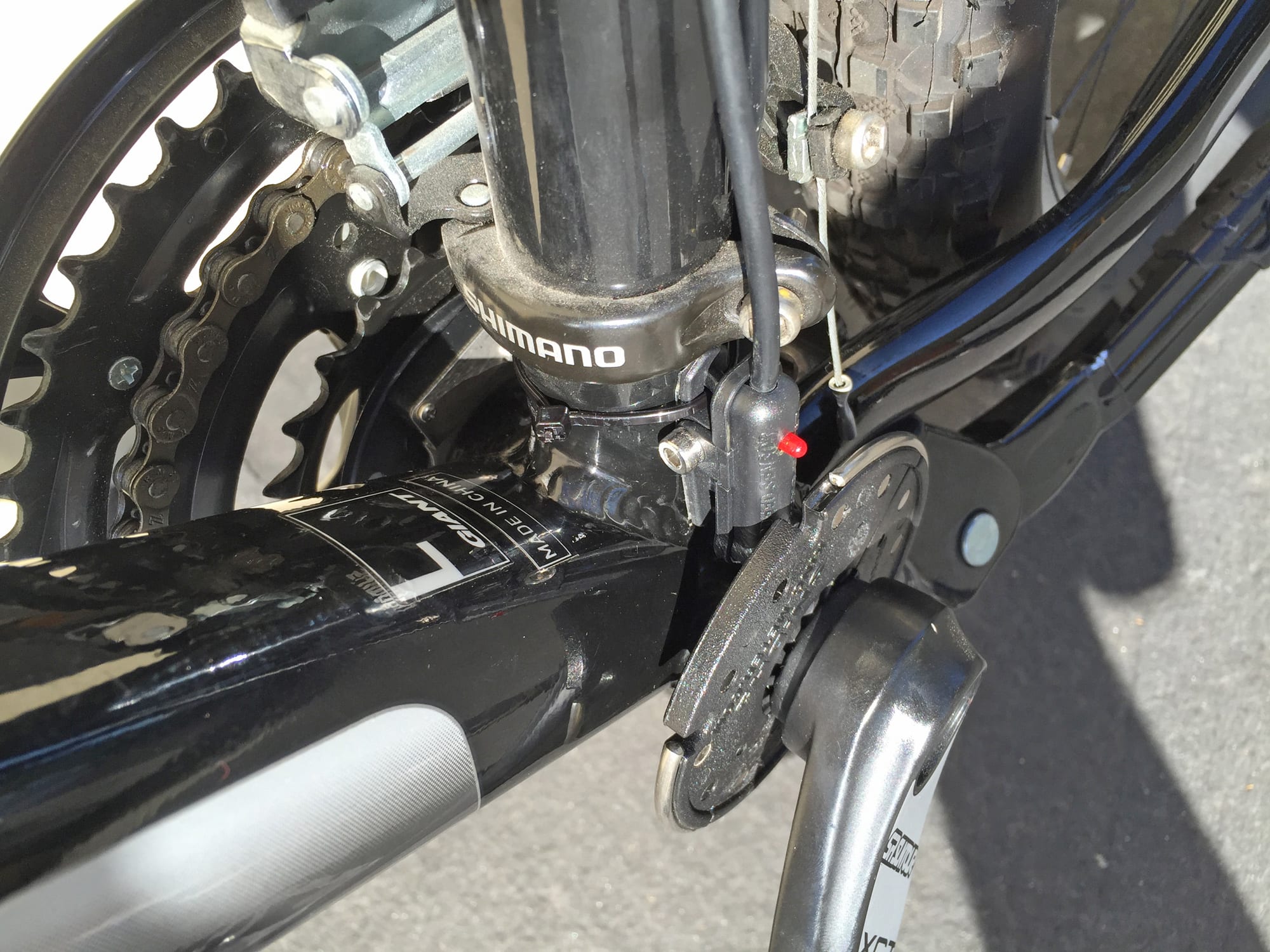

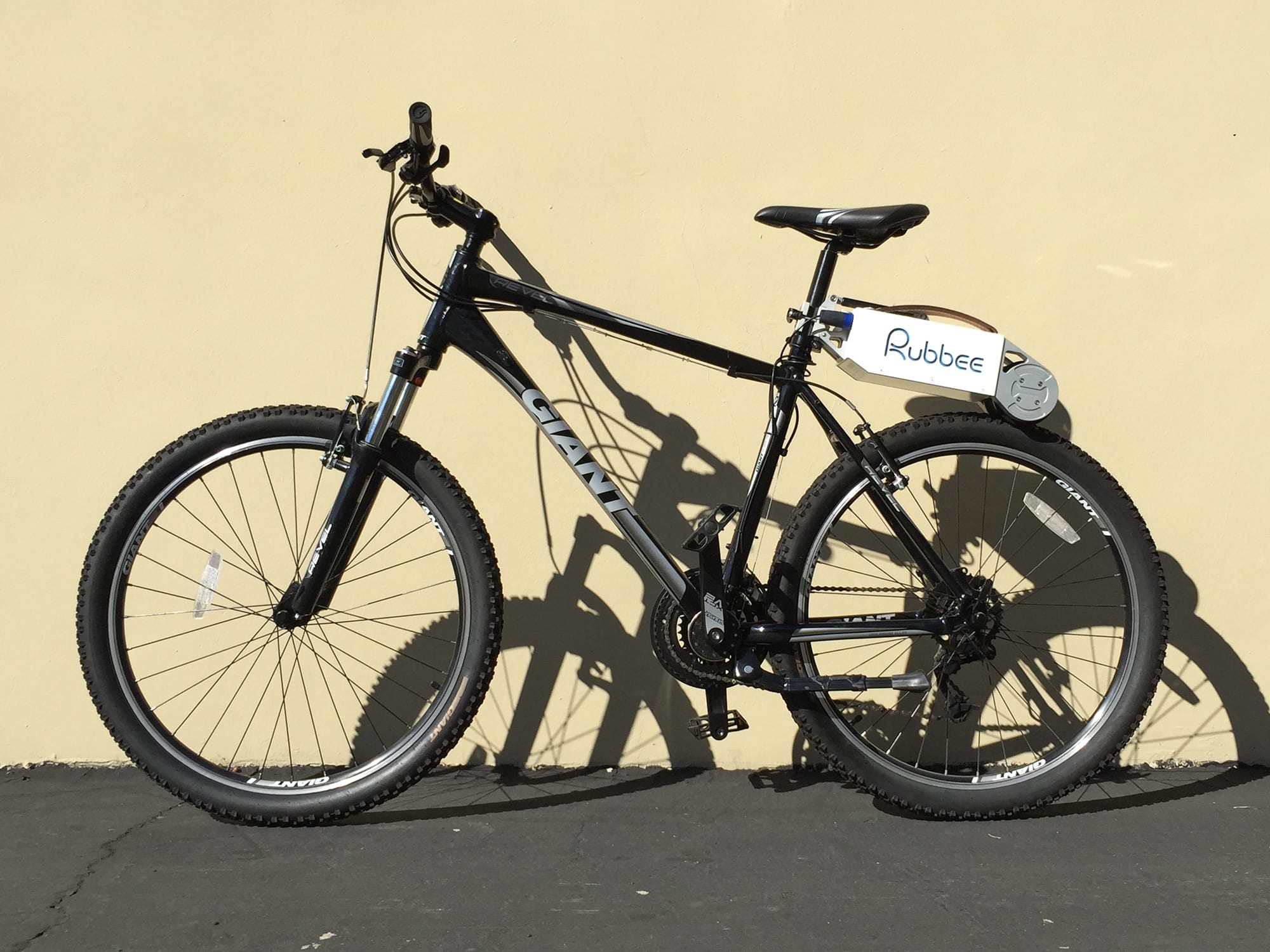
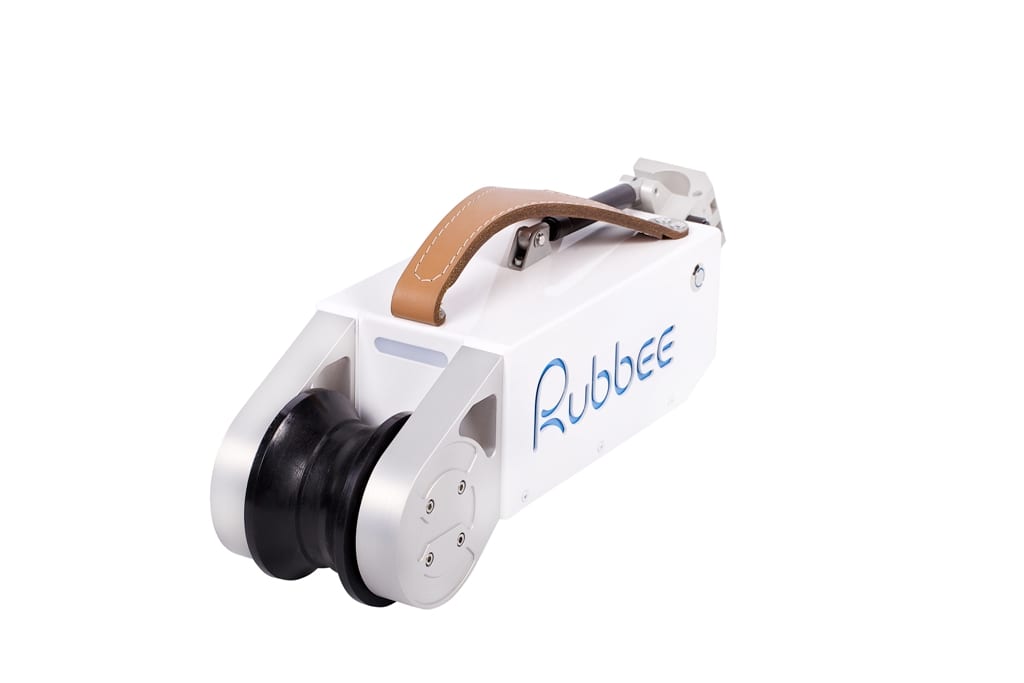
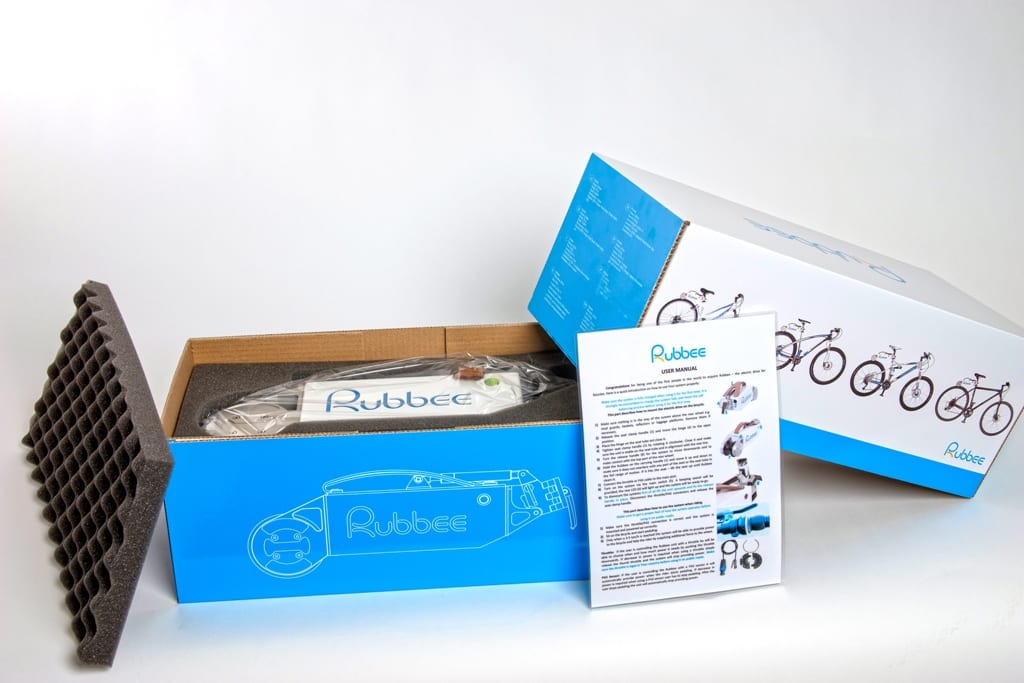
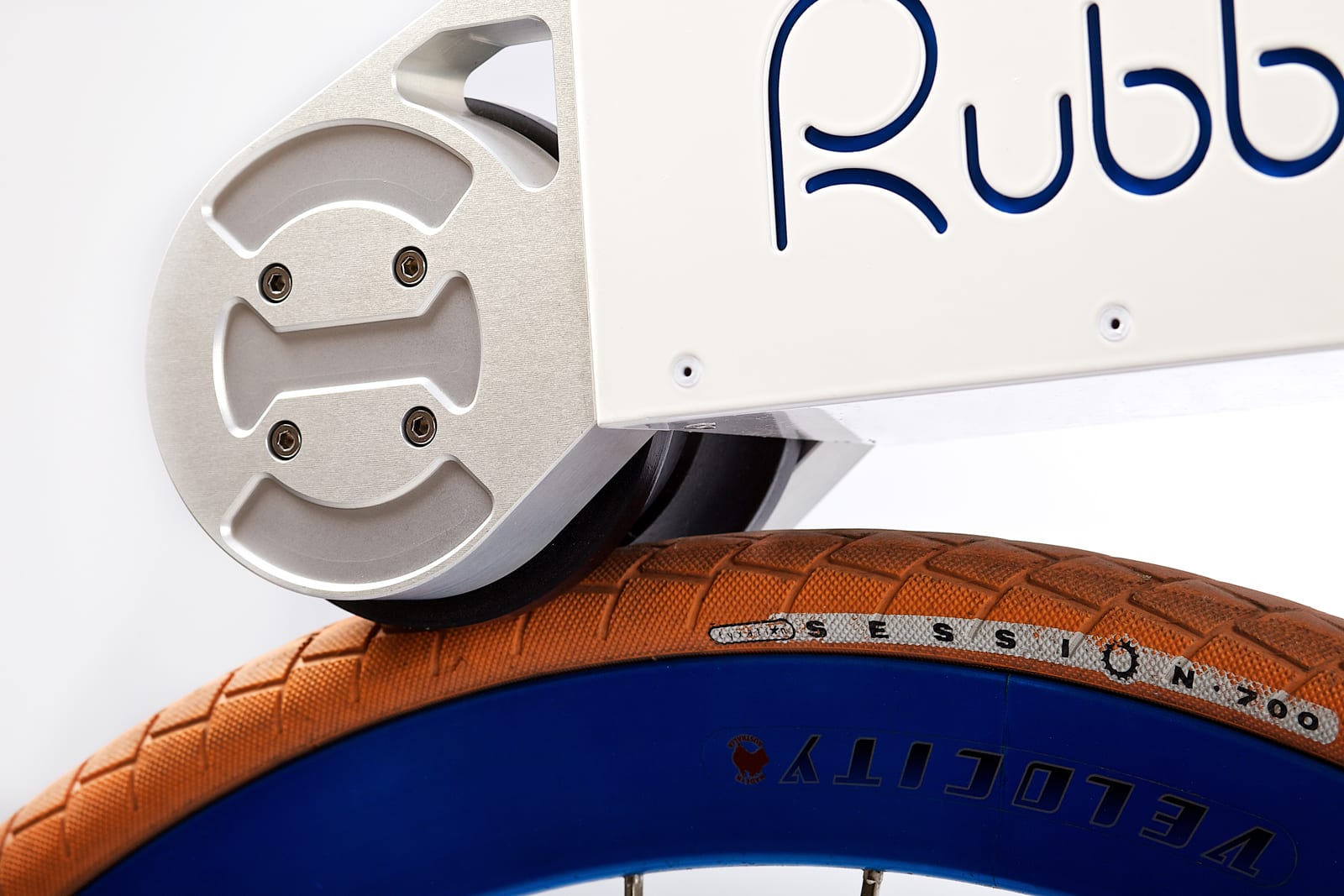
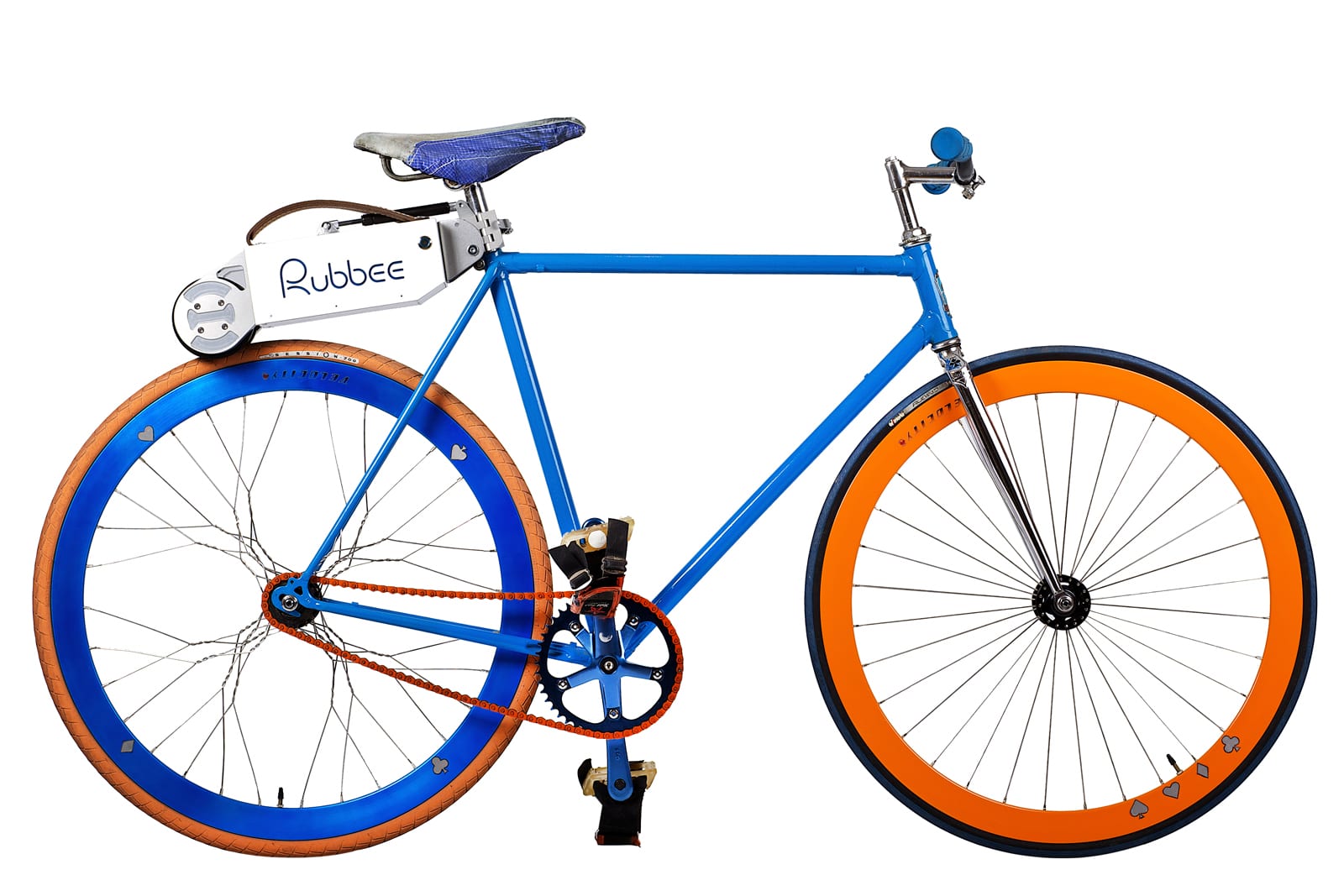

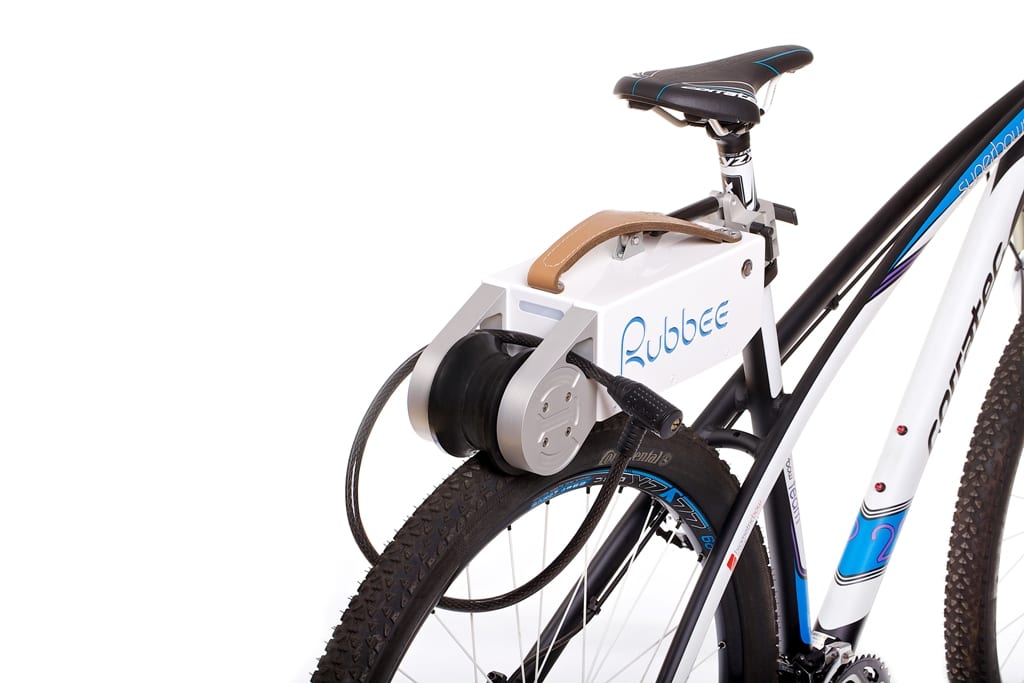
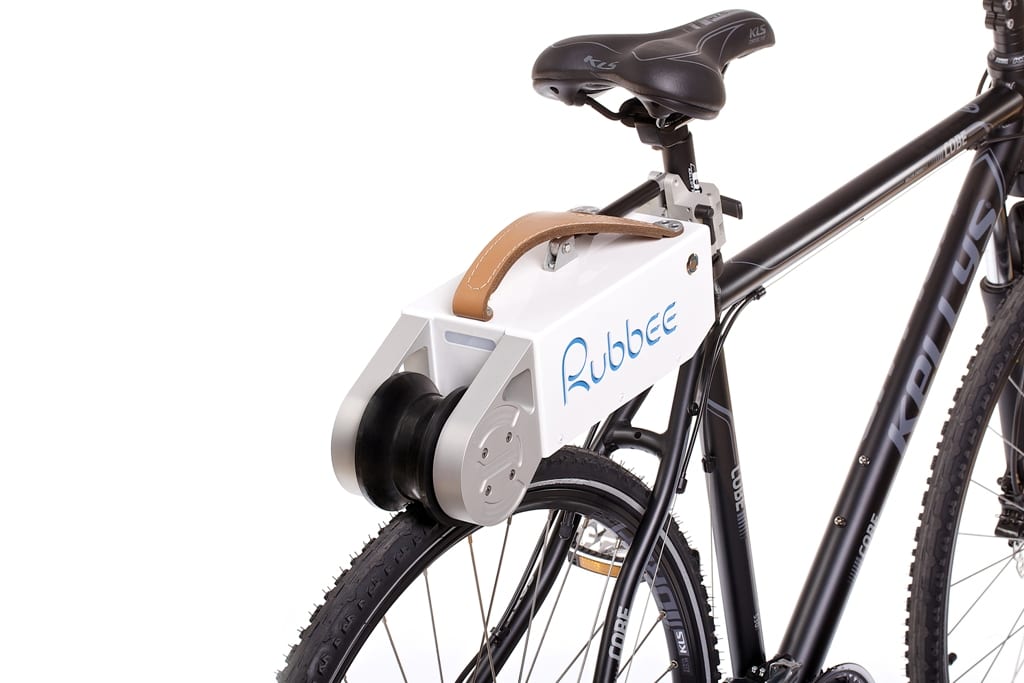
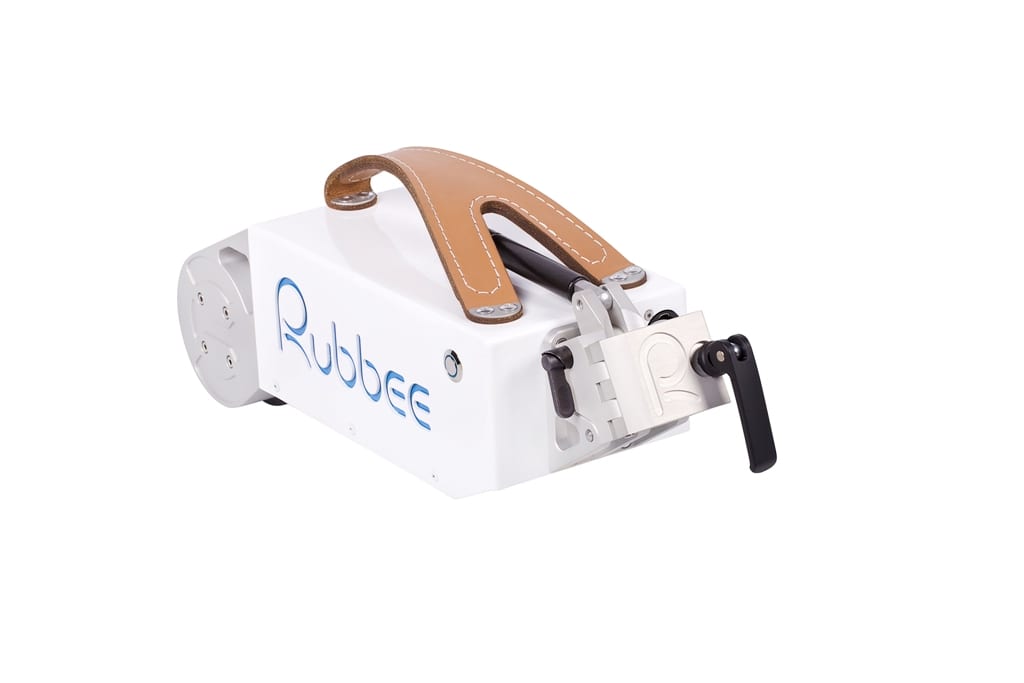
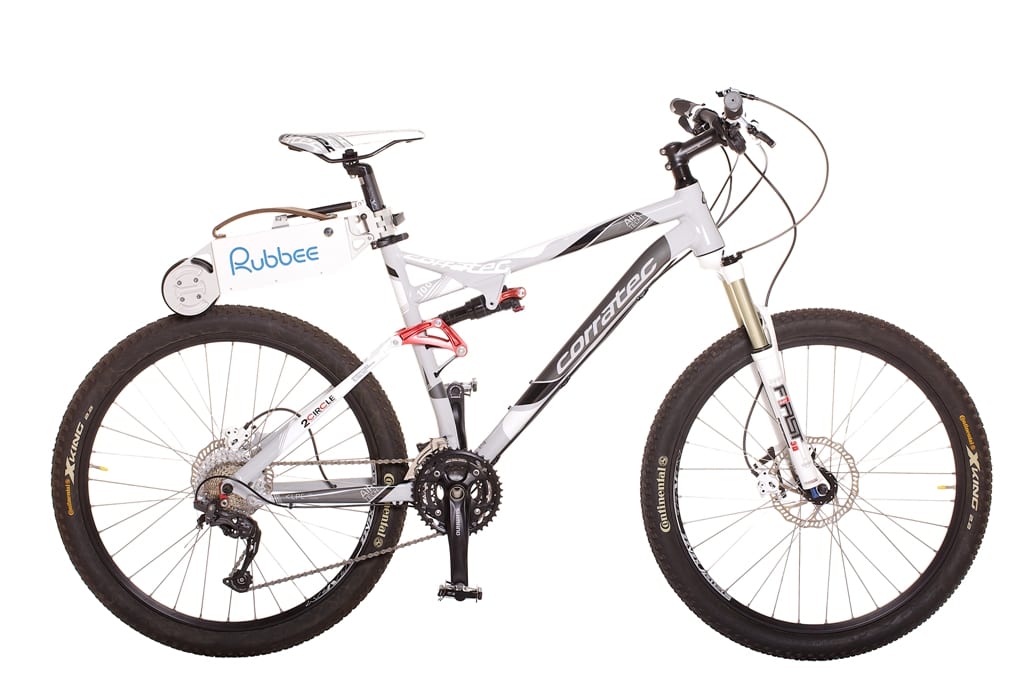
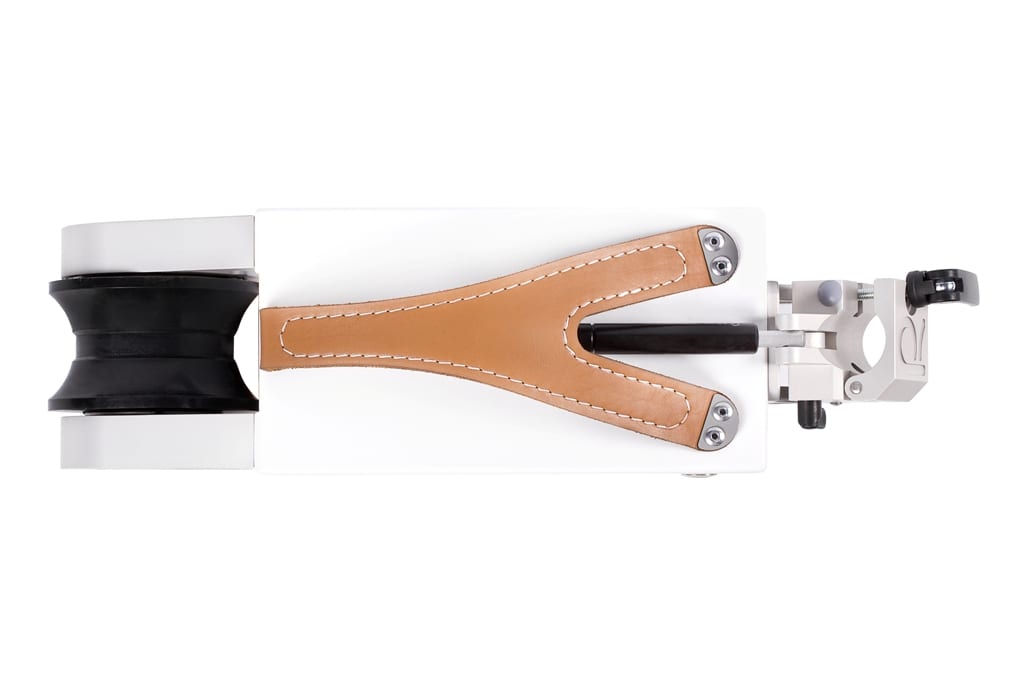

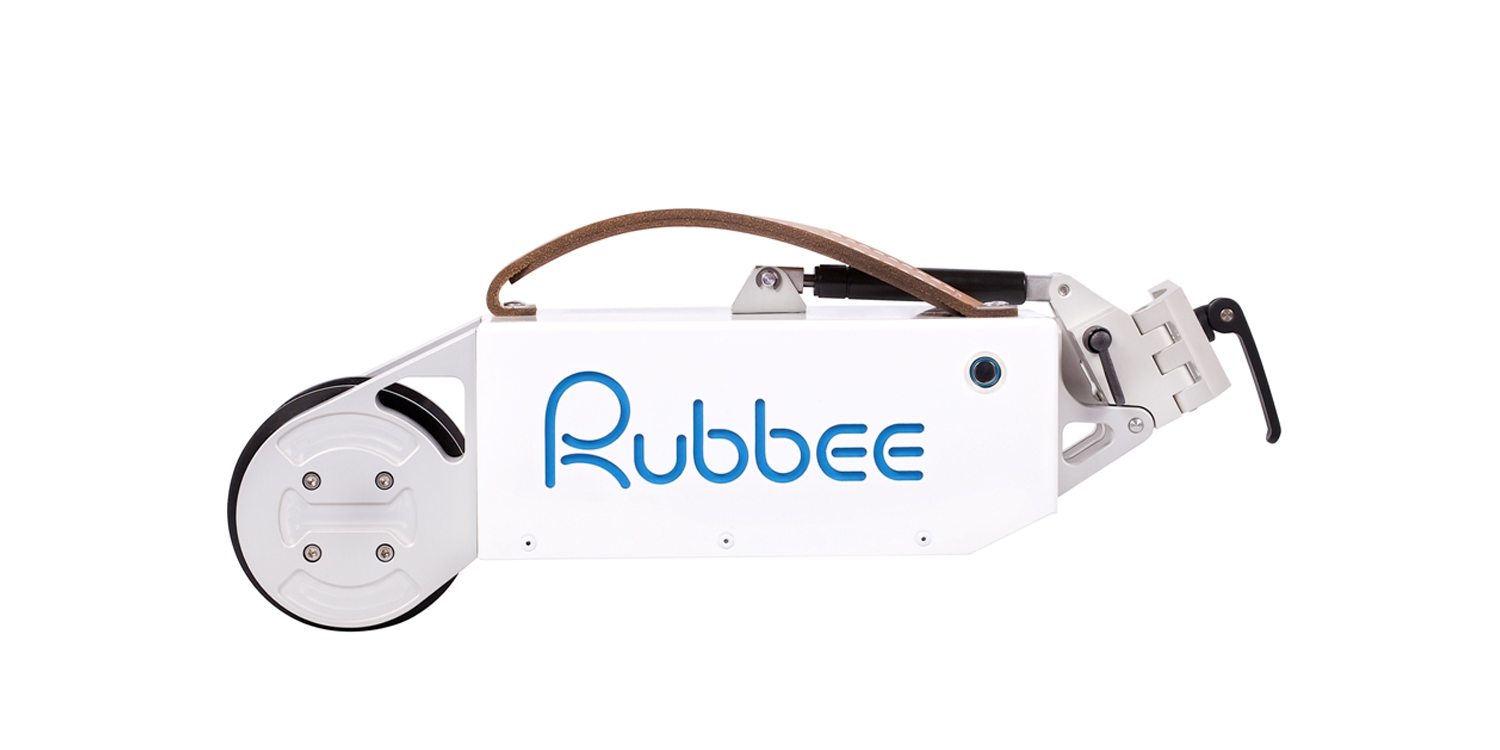
Boyd Peterson says
I was interested in the Rubbee electric assist motor, but after reading all the comments from people that have purchased this item it looks like one to stay away from. Too many people tried to return them, faulty switches, stuck power switches etc. I decided to forget this item. Too bad, it looked like a great idea………oh well.
Court Rye says
Yeah, the finish is very professional and I see the vision but it just didn’t work that well… I was surprised and amazed how well the older Go-Ped GoBike worked (and it was made in 2006). There’s a new friction drive system that was being crowdfunded called the add-e. I’m hoping to check that out at some point :)
simone says
Hello everyone, I’m looking for the go-ped gobike or one of rubbee 2.5/3.0. Since I can’t find the older models, are any of you willing to sell them?
Court says
Hi Simone! Perhaps you could ask this same question in the EBR forums. There are many sections including a category for Rubbee, GoPed, and a for sale by owner area.
Nirmala says
Here is another one that just was launched on Indiegogo. I just ordered the smallest version to try on the front wheel of my Magnum Ui5 for some more oomph on hills. I look forward to trying out an AWD ebike! It would be great if you could get a hold of one to review.
Court Rye says
Nice! I really like the concept and got to meet the founder of ShareRoller last year in New York. I shot a review of his first version here. Sounds like the new one is smaller, lighter and quieter! Hope you enjoy yours, can’t wait to hear more and maybe review the latest version too :D
Matt Pintar says
Where can I see a Rubbee Drive . I live in New Jersey.
Court Rye says
I bet you could reach out through their official website and meetup near NYC. That’s where I met the founder for this review :)
Vijay kumar sharma says
Dear Dir/Madam, I am Indian, live in chandigarh and want to buy Rubbee latest model .plz guide me can I shipping this product to India.
Court says
Hi Vijay! I think that Rubbee went out of business since this review was created. I keep it online for people who may have purchased the product and now wish to find details or see images of what it looked like, if they are buying/selling used. Sorry!
Nikolaos Filopoulos says
If you still want one please PM me on [email protected], I have a second hand one for sale, as I have upgraded to a mid drive e kit.
michael rouse says
in the chair of an international NGO and we want to test this type for the poor if anyone can reach-out to us to do trials we have head offices in UK and would love to develop our own low cost version in collaboration if we have some team players and tech advise
Court Rye says
Hi Michael! I can’t speak on behalf of the Rubbee company but you can reach them via their website here http://www.rubbee.co.uk/contact and if nobody responds just email me using the contact form on EBR and I’ll try to make an introduction. Sounds like a very cool project!
Jonathan Fulford says
I purchased a cargo bike that came with one of the early one. I could not get any charge and ending up sending back to them at vast exspense on postage, it needed a new battery. Top tip don’t leave it flat for too long.
Nice idea I used it a few times just for a laugh but sold it on in the end on auction site
Court says
Good advice, Jonathan! I’ve heard that if you let batteries discharge all the way it can damage the chemistry and you need to get a shop to work on resetting it somehow but I don’t know how that works or if it fully restores the pack. I’ve heard that keeping Lithium-ion batteries charged between 20% and 80% is best, and avoiding extreme heat.